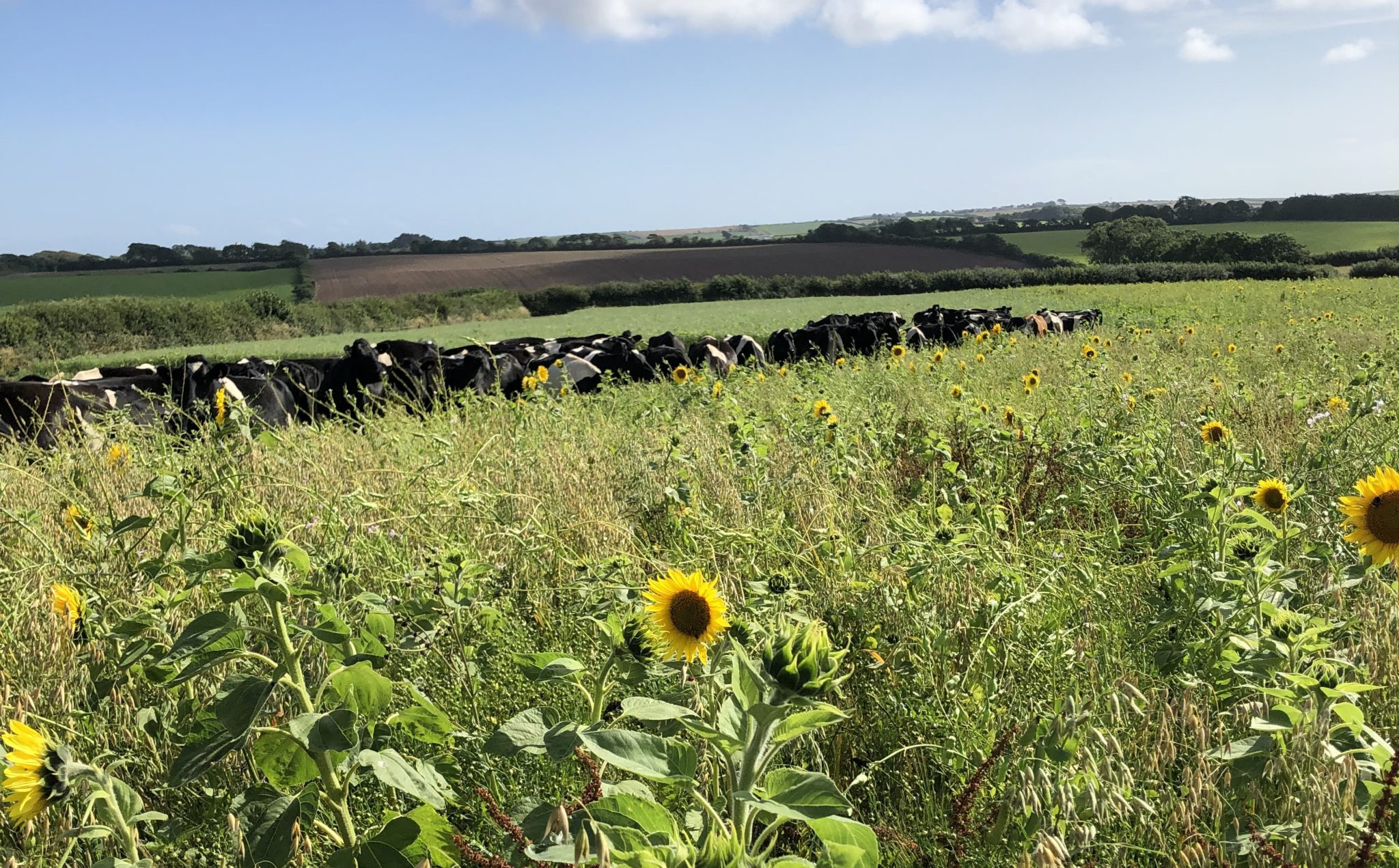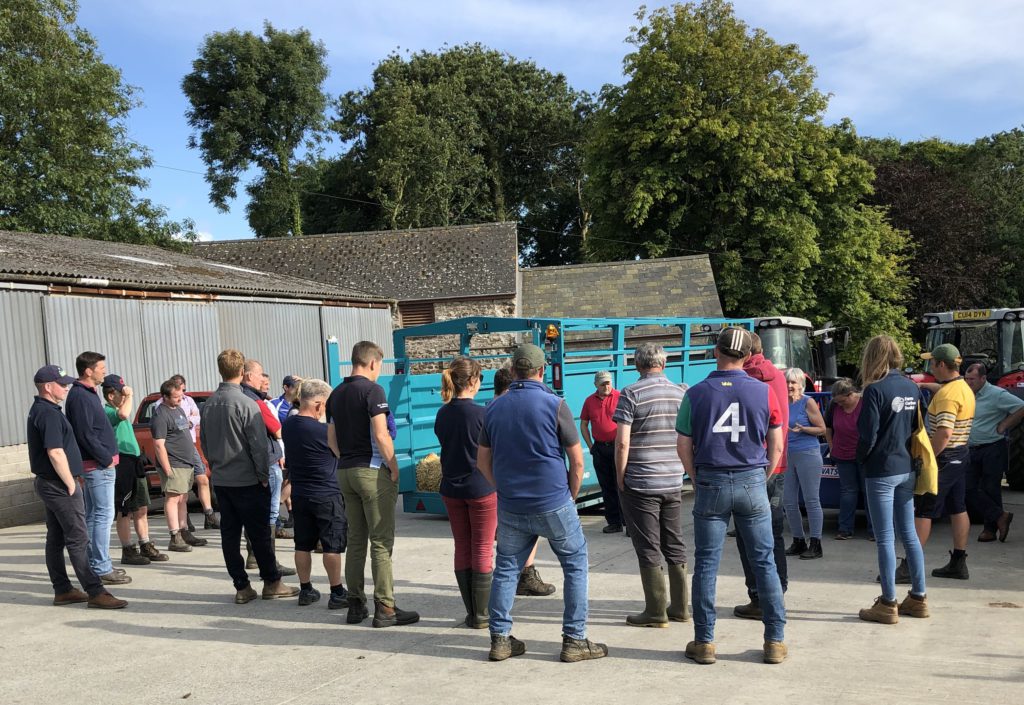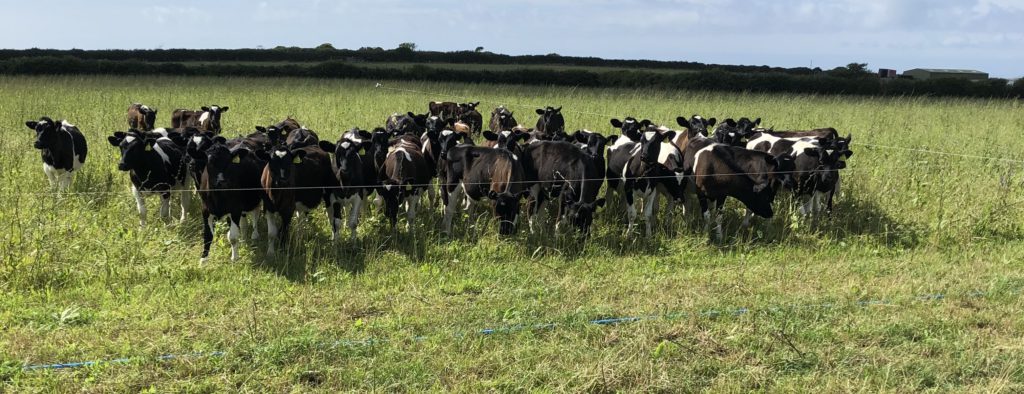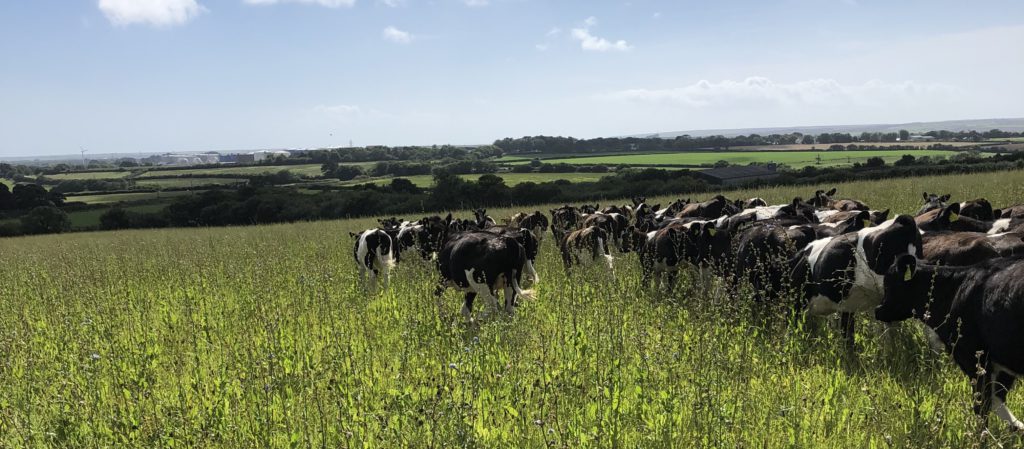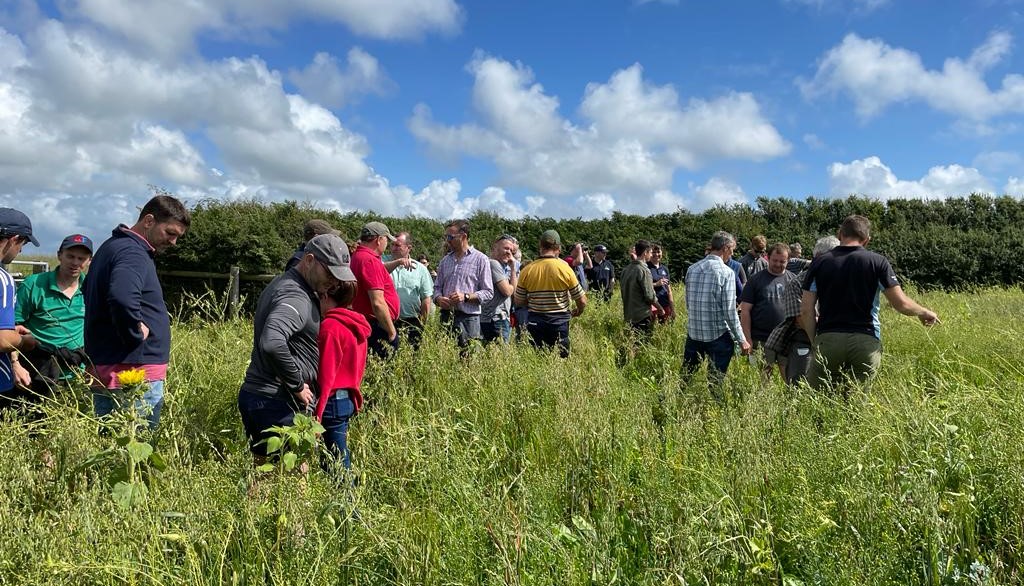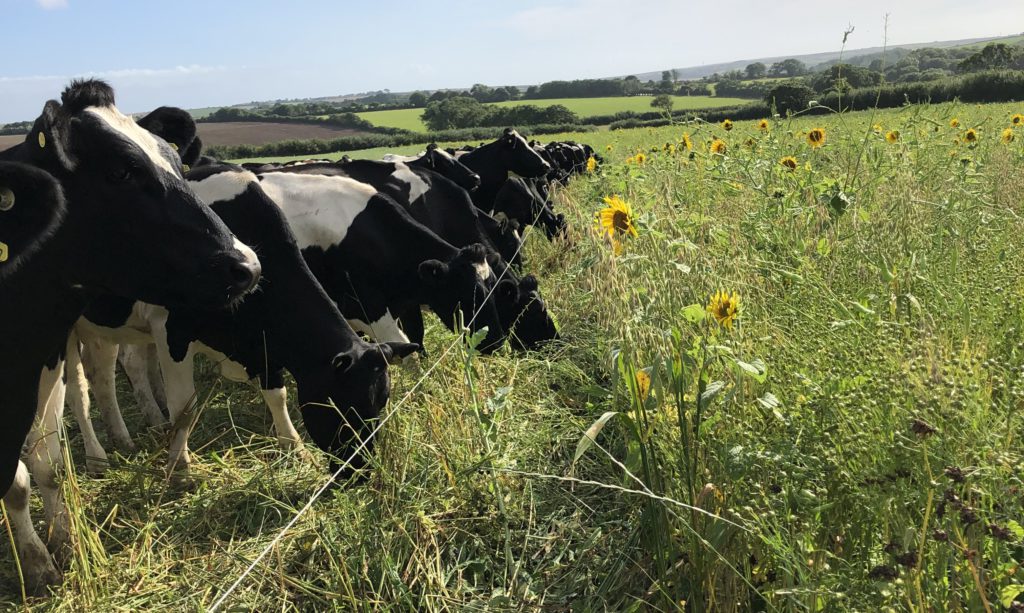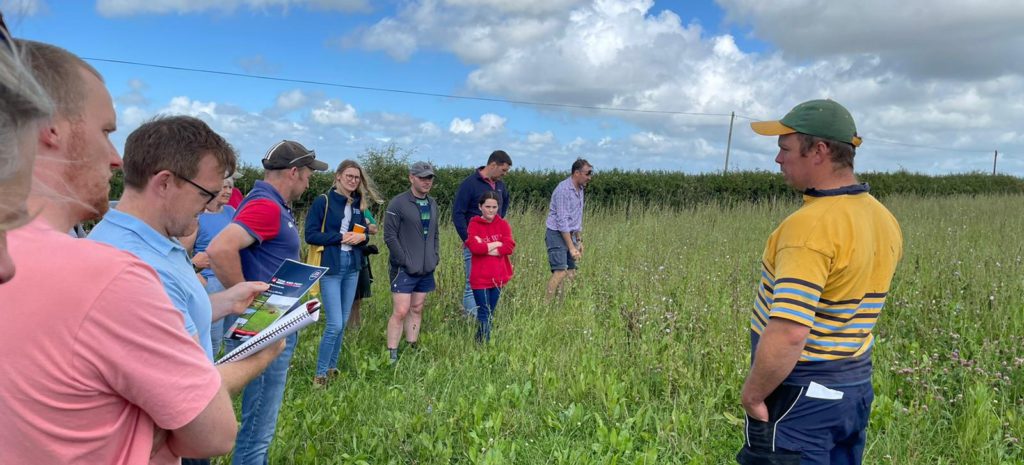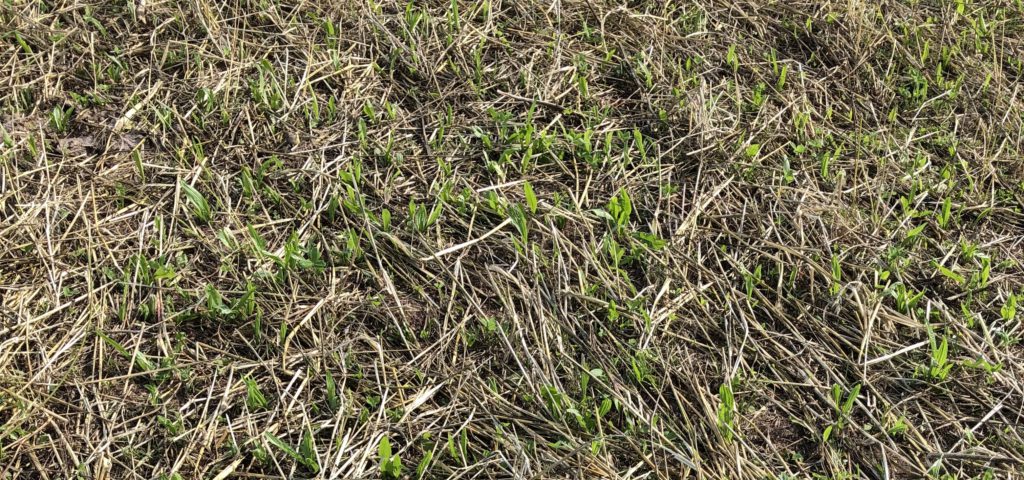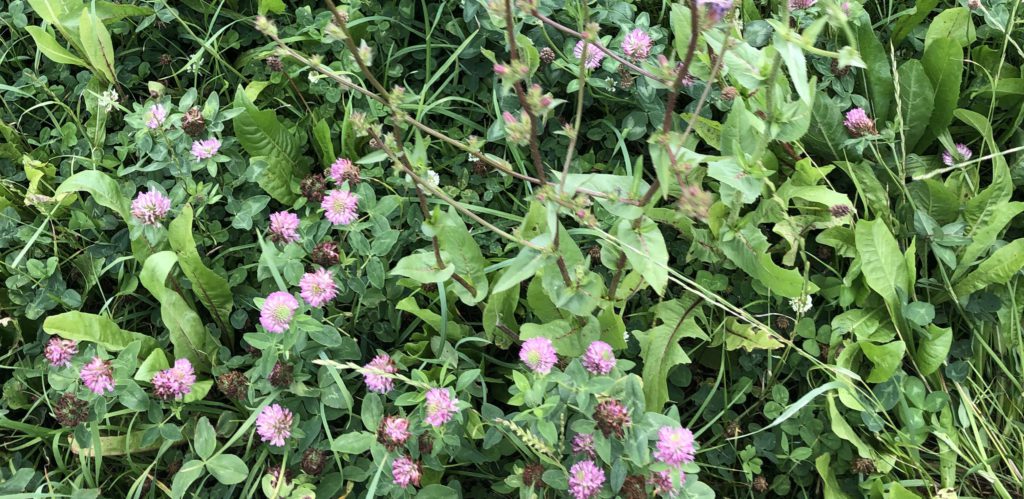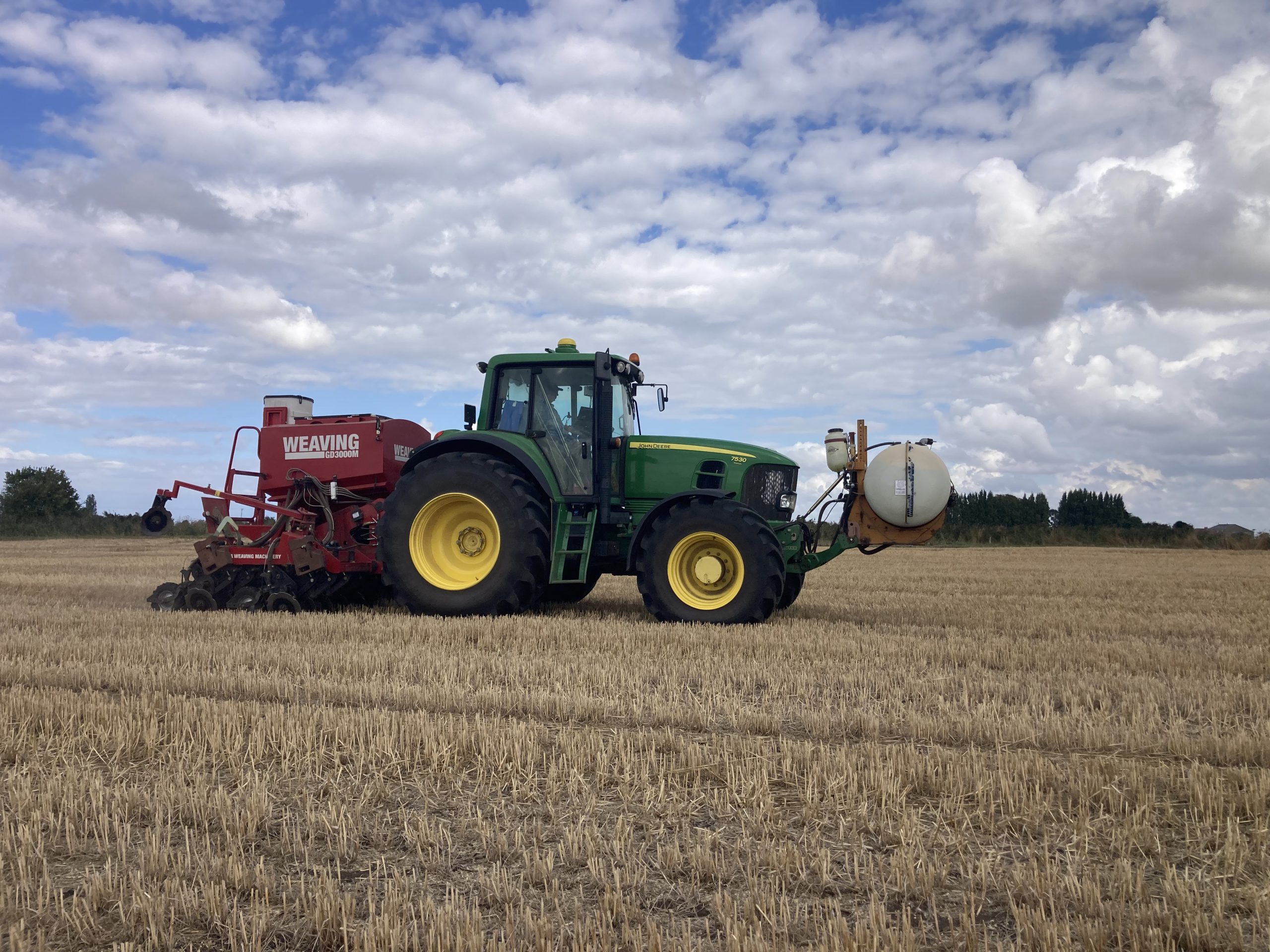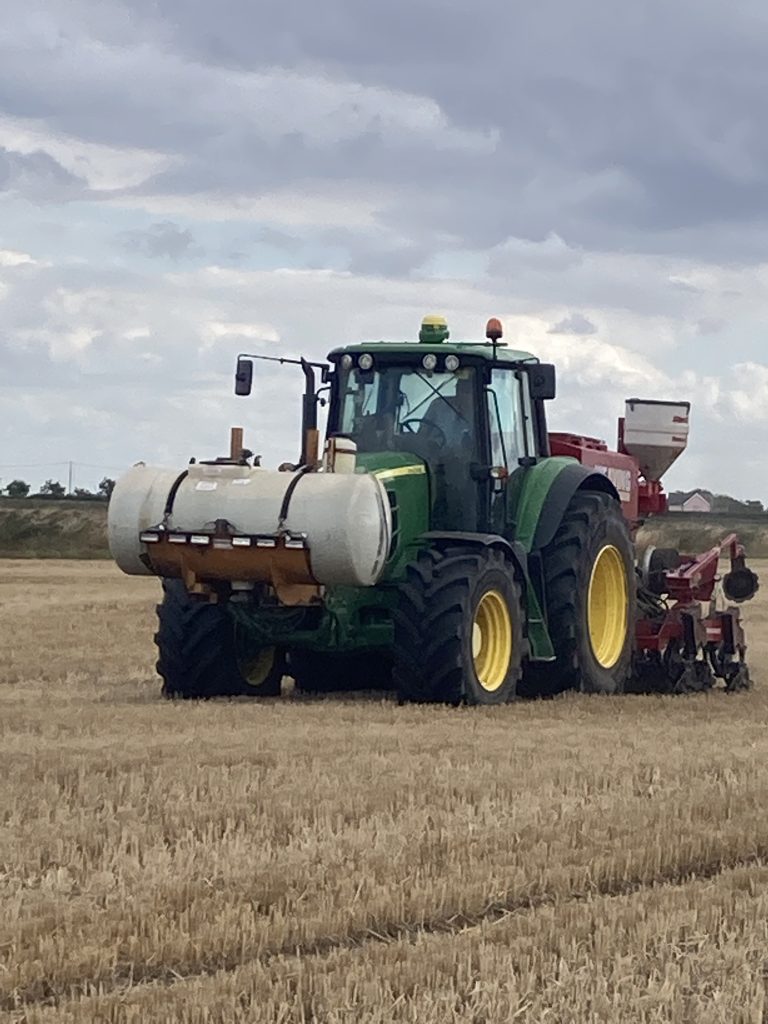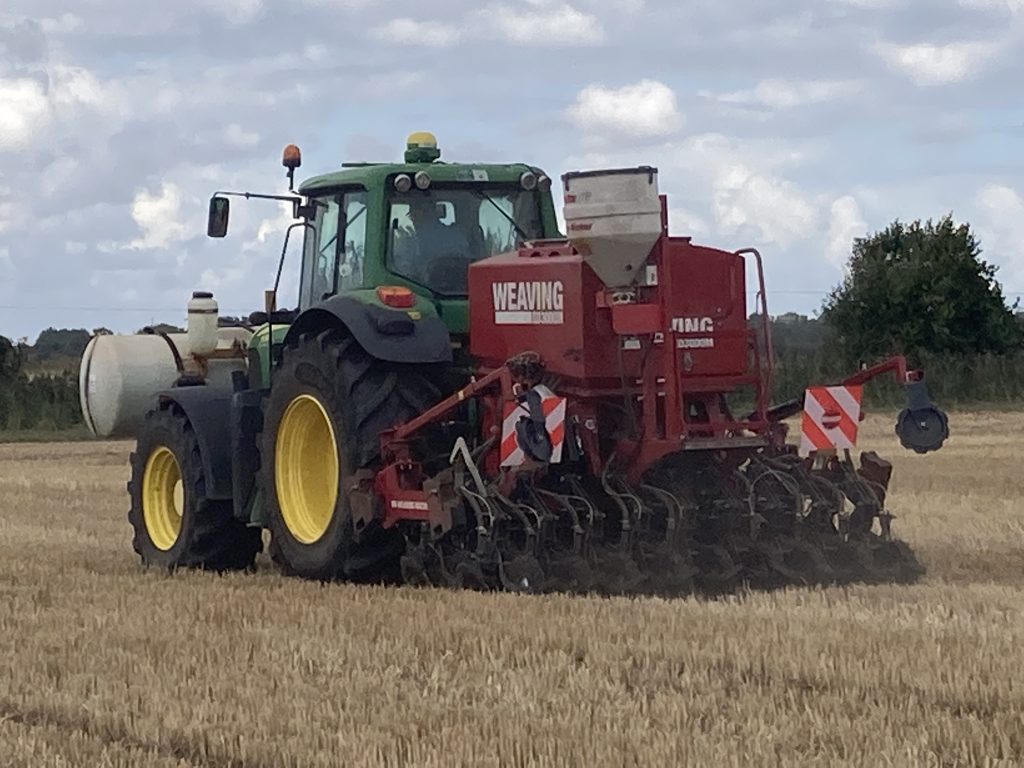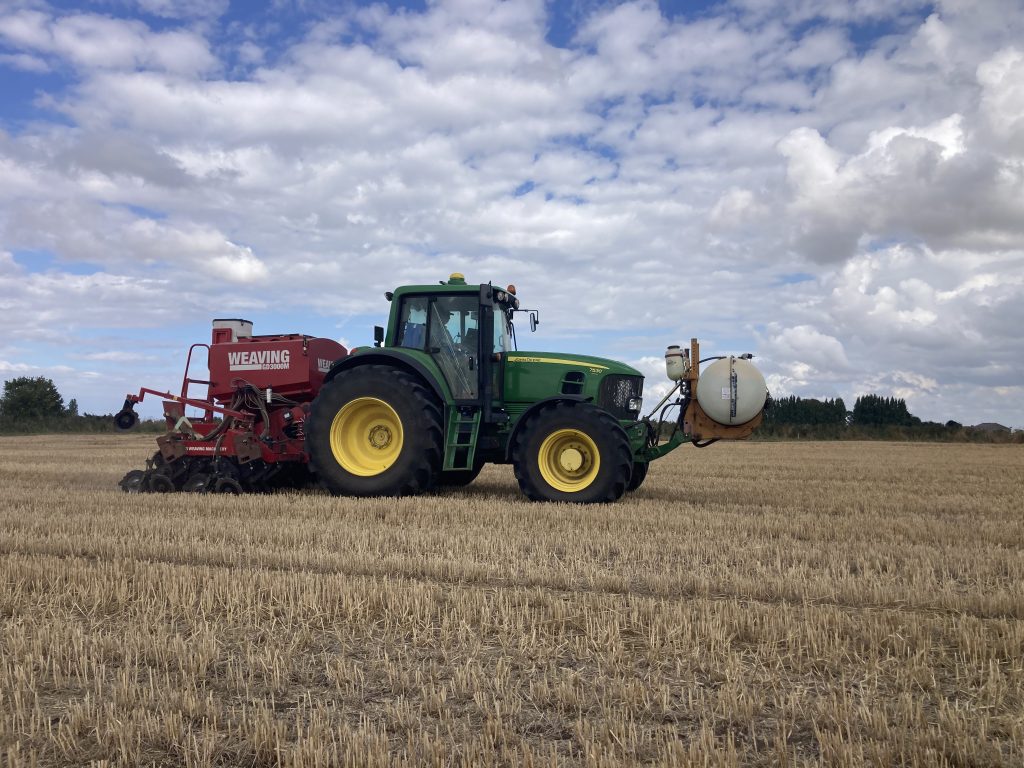If you would like a printed copy of any of our back issues, then they can be purchased on Farm Marketplace. You can also download the PDFs or read online from links below.
-
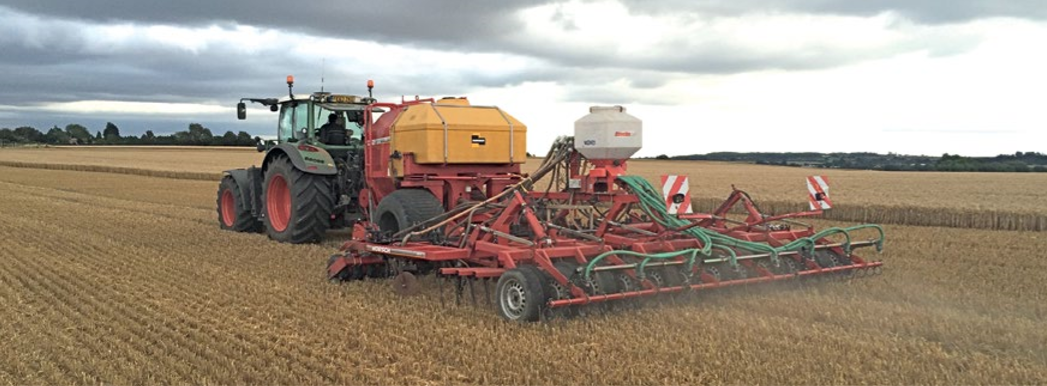
How To Start Drilling For £8K
Clive Bailye’s seed drill of choice is his 6m John Deere 750A , which has been used exclusively for 3-4 seasons. Last year, with an increased acreage, the founder and publisher of this Direct Driller magazine thought a second seed drill was necessary. Having just the one machine was a risk and in a difficult season would mean drilling was delayed. He looked around and found a good condition Horsch CO6 tine drill advertised in Germany.
Words and pictures by Mike Donovan
After delivery he rebuilt the coulters to a narrow profile so as to reduce soil disturbance. He says the tine drill is very useful driling after straw crops such as osr and also through the straw on second crop cereals.
Buying the drill from a German farmer was not particularly complicated, and provided him with a higher spec machine than Horsh sell in the UK. The seed dart tyres are much wider, and the machine is fitted with blockage monitors as well as full width front packers and also a liquid fert application system.
A sheaf of photos were taken, and Clive then asked for some of specific parts to show wear. The deal was done at under £5,000 which Clive says is the market value of these machines which are too large for small farmers to buy. Original owners like to buy new and sell when the machine is still in good condition.
Narrow tines with wear tiles
@Clive knew he wanted to make changes, substituting the Horsch tines and coulters for something far narrower, and has ended up getting his own design of tine made, which has a wear tile made from Ferobide, far harder than tungsten. The drill is on the farm primarily for osr and 2nd crop cereals drilled into chopped straw and the 25cm spacing is okay for these crops.
Comments on Clive’s on-line forum, TFF, said the drill many not be so good with beans, as the slot is a mere 12mm wide. And in barley the spacing may well be too wide as it needs to be thick. Clive points out that the seed pipe can actually be a bit wider than 12mm as it is in the shadow of the point. It would be good to have the option of using it for beans.

Above left: The cheap CO6 is being calibrated ready for its first outing

Above right: The adapted Horsch is being filled by the home built drill logistics trailer with seed and liquid starter fert.
Getting around the German instructions
The Horsch came, of course, with a control box and instructions in German. More on-line discussion revealed that English instructions were available on the Horsch website, and another explained that Horsch was sourcing some of these parts from Agton in Canada anyway. Zealman from New Zealand explained that the button marked with callipers should be held down for around 5 seconds. The menu is where you adjust the tramline sequence, valve layout and row numbers.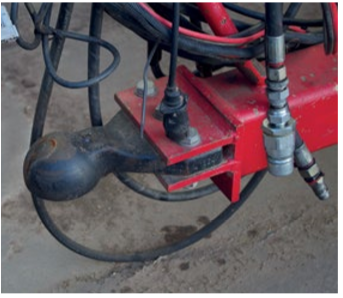
Ball hitch is a continental standard and provides a positive connection between tractor and drill

The Stocks Wizard has a rotor modified for Avadex which otherwise leaks everywhere
A Stocks Wizard is on the back of the drill and used for Avadex. Here again the knowledge of actual farmers is helpful. Alistair Nelson warned that the rotor and the surrounding shroud need to be changed, and he got good advice “from Rick at Stocks”. Clive has the same setup on the 750A and says that the Avadex leaks everywhere unless the modification is made. The drill was acquired and modified in 2016 and the results have been excellent.
The machine went through the residue without many problems and having the second drill has meant more timely planting. Clive has shown that moving into No-Till is not the expensive exercise so many farmers think it might be. The total cost, after modifications which included replacing all tines and coulters, was under £8,000.
Author Mike Donovan writes: we have featured a number of home made direct drills in @Practical Farm Ideas, and are always interested in seeing more. Please contact mike editor@farmideas.co.uk or 07778877514.
-
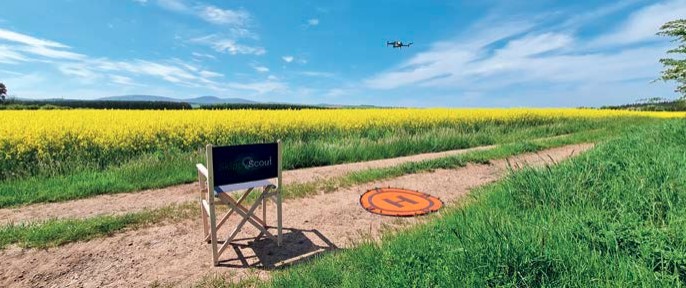
OSR Monitoring Reaches New Heights
New software that uses a drone to image crops has been developed to help farmers walk crops more quickly and accurately. Skippy Scout has been developed by farming technology specialist Drone Ag to monitor a variety of broad acre crops. The latest developments in the software’s version 2.5 enables users to import field maps and track the crop from emergence to harvest. The data from each flight is recorded and reports generated that help to evaluate the crop throughout the growing season and collect data to compare growing trends and yields year on year.

Oilseed Rape (OSR) yields are affected by a variety of pests and environmental pressures, from cabbage stem flea beetle to rare late frosts. “Monitoring OSR more closely and regularly without the same time trappings of conventional crop walking can help to make vital decisions,” says Drone Ag founder Jack Wrangham. “Skippy Scout automates drone flight to view a field up to ten times faster than on foot,” he adds. By decreasing the amount of time needed to walk a field, and increasing the amount of data collected, Mr Wrangham believes that any farmer can see incremental yield improvements in crops like OSR.
Unlike some technology developers Mr Wrangham is a farmer. His brother Hugh works with his father John at the family’s 600-hectare arable farm in Northumberland. “At Harehope Farm, we have been using Skippy to monitor 15 fields over the season, each field had an average of nine key scout points, and each field was visited five times. To do this on foot would have taken 21 hours, with Skippy it took five and half,” he says. The scouting point locations are decided based on a combination of previous problem areas, satellite imagery showing areas of different biomass, and some additional points to balance data across a field.
Following variable rate sowing at Harehope the Wrangham’s use Skippy Scout to provide accurate post emergence plant counts. “This helps in any areas that have been missed and measures how effective variable rate drilling has been,” he says. Following early emergence, flea beetle is a concern for OSR. “It is crucial to find and identify flea beetle early, and with Skippy we can monitor fields faster and more regularly. Holes in the leaves are counted by the app and reports show the extent of any damage sustained. Areas with higher levels of damage are flagged to decide if spraying is necessary,” he adds. The effectiveness of subsequent crop treatments is also measured by further drone flights to image the OSR and track any further signs of damage increasing or decreasing.
Data collected has been used to make year on year adjustments to OSR. As the crop develops, an accurate green area index (GAI) can be taken at regular intervals to understand crop vigour, nutrition requirements, disease, and pest levels. “Using crop cover percentages and GAI we are able to adjust and learn from previous treatments to find and tackle problems earlier,” says Mr Wrangham. The damaged areas can be monitored throughout the crop cycle to minimise any losses in the current year and better understand what factors are making a positive or negative difference. “It’s all about having hard facts, statistical data, GAI and plant counts at the press of a button. It would not be realistic to walk the fields as many times as is possible with a drone, and the reports produced can be saved to help make decisions for future crops,” he adds.
Using the app has reduced the frequency and quantity of inputs needed at Harehope. “We also use the GAI readings for variable rate Nitrogen (N) applications. Satellite data is a useful tool, but it is often not enough because the weather prevents being able to see the crop regularly enough. We have also found that it provides inconsistent data because it does not differentiate weeds,” he says. The GAI readings provided by Skippy Scout are crop-only. This is because the drone flies close to the ground making its view of the crop more accurate. “When combined with satellite data, simple zoning is effective in reducing the amount of N needed to create a more even crop,” he says.
Despite the option to variably apply N to OSR, the Wrangham’s chose to apply at a flat rate per field this season because Skippy Scout was able to show that GAI was quite even across the crop. 234 kilograms per hectare was applied over two applications based on the average GAI recorded by scouts made with the drone on the day the application was made. “Using the reports from Skippy has allowed us to make better use of our inputs. We are more efficient and better informed to make applications,” explains Mr Wrangham.

This helped to develop one of the app’s new functions which helps users judge how to balance the use of inputs. “Crop evenness is a percentage value of crop variability. It identifies whether variable rate applications are needed and tracks how effective the decisions are through a season. One hundred percent is a completely even crop, and lower percentages reflect the impact of treatments and inputs on the crop,” he says.
The Wranghams have targeted a GAI of 3.5 at flowering onset as a key performance indicator for OSR. Regular drone flights that capture GAI show how the crop is developing through the growing season and enable adjustments to be made. “As the crop begins to flower, we are able to see how areas that are not meeting the target 3.5 GAI are going to affect the overall yield,” he says. This begins a process of careful monitoring to estimate yield in the run up to harvesting the crop. “Skippy has a flower fraction measurement that identifies the intensity of flowering. This, along with GAI measurements, helps to estimate yield and a later measurement of crop die-off helps to decide on desiccation and harvesting timing,” he says.
2020/21 has brought late frosts to OSR crops throughout the UK. “Skippy has highlighted that crops of highest early autumn vigour suffered, as they were well into stem extension when the cold weather hit in early spring. It is possible to establish this by using Skippy to count the pods on the stem of the plant,” says Mr Wrangham. This is also helping the farm to judge the timing and amount of fungicide. “Flowering has been prolonged in many crops this year. Skippy has been a good tool to identify fungicide timings for a second or third Sclerotinia flower spray in some places,” he adds.
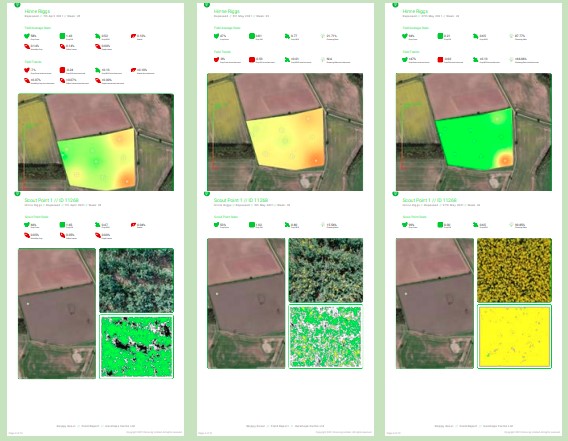
Regular flights help the farm to gather data about flowering decline and crop die-off. “The reports generated from each flight provide an indication of green area duration and whether or not a late foliar N application would be worthwhile. When this is compared with other metrics through a season it is possible to estimate overall yield more accurately,” he says. This not only helps during a single growing season but is also creating a library of data that can help to predict how changes in the crop, or weather conditions, can improve future yields.
Tracking and logging the effect of the decisions made is the defining difference of using drone reports. Having a constant record of every flight and understanding the impact of choices based on that data is offering answers to common problems. “Often decisions can be made with relatively little data, but with Skippy it is possible to build up a database of specific points in each field and make incremental improvements with each crop,” says Mr Wrangham. This is applying a more scientific approach with an element of trial and error. “Skippy can help users develop techniques that produce healthier crops with higher yields more efficiently, by reducing costs and the use of chemicals,” he concludes.
-
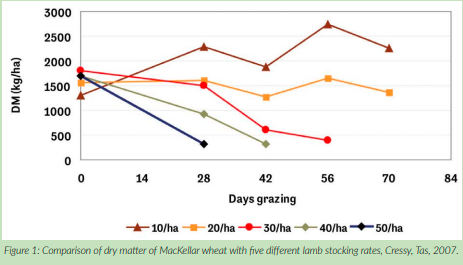
Grazing Cropped Land – Part 4
The almost forgotten technique in the UK of grazing cereals is something being widely practiced across Australia in areas with widely varying rainfall levels. The Australian Grain Research and Development Council have produced a report titled Grain and Graze which sets out to evaluate the advantages and disadvantages of grazing a range of cash crops. We began serialising this report over forthcoming issues, exploring what is currently an untapped resource.
Originally Published by Grain and Graze in Australia in 2016 and continuing on from Issue 6 of Direct Driller MagazineStocking rate (intensity and duration of grazing)
The three considerations of when grazing starts, the amount of crop to leave behind and when to stop grazing enables a calculation of the total number of grazing days available. Once this is known, the grazing intensity or stocking rate can be calculated if animal consumption is included. Where only a small grazing ‘window’ exists before GS 30 is reached, very high stocking rates are appropriate. This ensures even grazing of the crop and avoids the ‘lawn and rough’ effect that can occur when stock concentrate grazing on a small area. If the period of grazing can be increased through early sowing or very favourable growing conditions, then the approach to grazing can involve a lower stocking rate for a longer period of time. In this case crop growth should also be taken into account.
The effect of different stocking rates on crop dry matter is illustrated in figure 1 below. Grazing at 20 lambs per hectare roughly maintained crop cover. At higher stocking rates dry matter declined and at lower lamb numbers, crop growth during grazing was in excess of animal intake. This suggest crop growth was approximately 30 kg/ha/day (20 lambs eating 1.5 kg/hd/day).

For many farmers a significant challenge is to find enough stock to graze the crop evenly within the grazing window. This is especially true if the cropping paddocks are large, sowing is early in the season or there are many crops that could be grazed all at the one time. Temporary fencing is one way of creating smaller paddocks so that the grazing intensity can be optimised.
Multiple Grazings
Multiple grazing can be undertaken which gives access to more dry matter, however, the second and subsequent grazing are likely to occur after GS 30 has occurred. This usually results in a loss of grain yield (table 1).
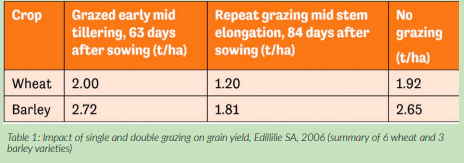
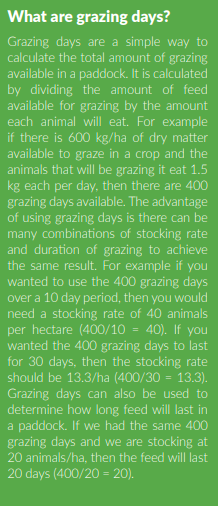
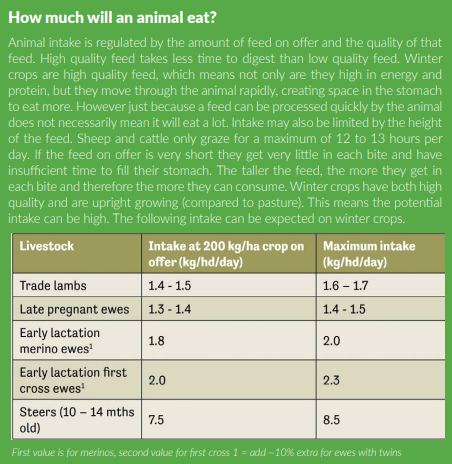
Grazing Cropped Land
There are other considerations that farmers need to appreciate when grazing winter crops. The information presented here seeks to quantify the magnitude of these risks under different situations. With this understanding, each farmer can make a decision on whether to accept the risk and graze the crop.
Stubble after grazing
In most cases grazing will reduce the amount of stubble left compared to no grazing. The average across all observations was 37%, although there is less effect the earlier the crop is grazed. The average reduction during early vegetative growth was 18%, 29% during tillering and 64% in early stem elongation. The smaller reduction when grazed early is probably because there is more time for the plants to recover before stem elongation commences (figure 2). The reduction in remaining stubble may be useful for farmers who have difficulty managing high stubble loads. However for those farmers who can bale and sell the straw, grazing will reduce stubble available. There is limited information on the effect on silage or hay production, although it would be reasonable to assume similar reductions to the dry matter available for baling when grazing occurs.
Weeds
Creating weed problems is a common concern expressed by farmers grazing winter crops. The fear is that grazing removes crop competition, encourages germination of weed seeds and increases tillering once the weeds are grazed. Weed populations are dynamic, which makes a simple answer to the question does grazing increase weeds impossible to answer. However information from 12 trials conducted throughout the Grain and Graze program is beginning to shed light on weed populations and to enable some general statements to be made.
Weed free paddocks are the safest to graze When weed populations are already very low, grazing does not increase these populations, except with the possibility of opportunistic weeds such as toadrush (Juncus bufonius) which has an extremely long seed dormancy and only germinates when soil becomes saturated and pugged. An example is presented for annual ryegrass populations monitored for 4 years in South West Victoria (figure 3).
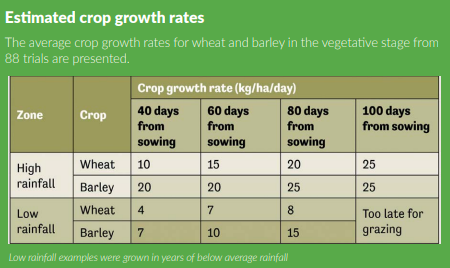
Crop competition is important in controlling weeds
Early crop competition will reduce weeds. This can be achieved through:
• Variety selection, using early vigorous types like oats and barley compared with winter wheat
• Higher sowing rates and narrow row spacing
• Earlier sowing, although this may compromise the timing of pre sowing herbicides
• Adequate fertility and soil conditions
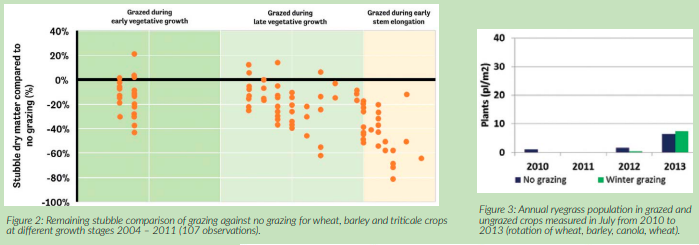
Grazing obviously removes plant competition and may change the subsequent weed populations. In a Tasmanian trial, the density of annual ryegrass plants was five to six times lower in ‘undergrazed’ plots with 10 lambs/ha compared with 20 lambs/ha or higher stocking rates of 30, 40 and 50 lambs/ ha (table 2). It was thought the extra leaf in the crop grazed with 10 lambs/ ha continued to shade the ryegrass, potentially reducing germination and vigour. In nil-grazed exclusion areas the density of ryegrass was comparable with the lowest stocking rate.
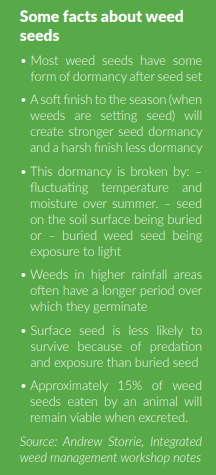
Grazing may increase or decrease weeds
The Grain and Graze data from 19 trials in Western Australia and Victoria (high rainfall) provides examples where weeds have increased, stayed the same or decreased after winter grazing (table 3).
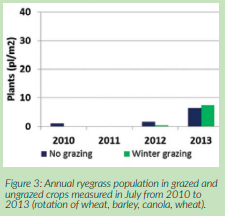
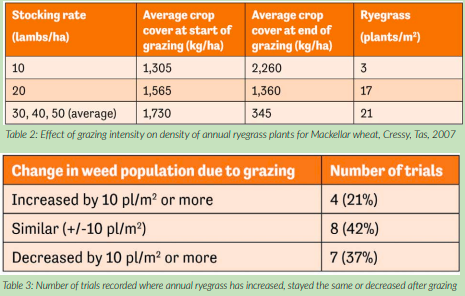
Intensity of grazing is important
If both weeds and cereals are intensively grazed to the same level early in the growth of the crop, the actively growing cereal re-grows more rapidly than most weeds, thereby putting the weeds at a disadvantage. Lax grazing, where only the top part of the canopy is removed has a tendency to reduce shading of the weeds by the cereal, allowing the weed to intercept more sunlight. While there are examples of sheep actively seeking out some weeds in a cereal crop, it is unlikely that this can be assumed over a range of crops, population of weeds, varieties and growth stages. Also the variability in the response of different weeds to grazing adds to the confusion. So what does this mean for grazing crops? The basic principles of weed control in winter grazed crops are the same as the practices used in ungrazed winter crops. Maximizing leaf production through high plant density, adequate soil fertility and selection for rapid growing crops all suit weed control strategies and DM production for grazing.
Soil structure
The impact of grazing on soil structure remains difficult to quantify. Trials in NSW and Victoria attempted to measure changes in soil structure after winter grazing which imposed extreme winter grazing conditions over multiple years. The main conclusions of this work were:
•Grazing resulted in visual changes to the soil surface (see picture) and reduced roughness in the soil surface (figure 4)
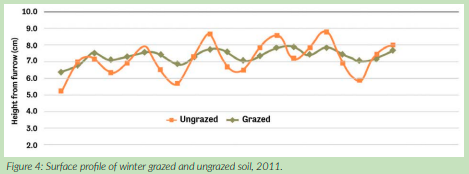
•There were no measurable changes to water infiltration or soil water storage as the result of grazing
•There was no difference in crop establishment in the year after grazing had occurred.
These findings are consistent with a review undertaken by the CSIRO that concluded grazing had no long term impact on soil structure and if there was any short term impact, the soil had an ability to ‘repair itself’, as long as the biological activity of the soil was adequate.
Animal health
Farmers who have been grazing winter crops in the last few years have observed some animal health issues. In interviews conducted with 14 farmers in South West Victoria who were grazing winter crops, 40% believed there were slightly higher ewe mortalities and 30% reported increased scouring and dags. Crops grazed in winter tend to be lush and are characterised by high moisture content and lower amounts fibre compared to more mature feed. This can potentially create animal health issues that need to be appreciated. Fibre Fibre is required in a diet to maintain healthy rumen function. It slows down the flow of feed through the animal (but can also restrict intake) and helps stimulate contractions or mixing of the feed in the stomach. Neutral detergent fibre (NDF) is the common test for digestible fibre in feeds.
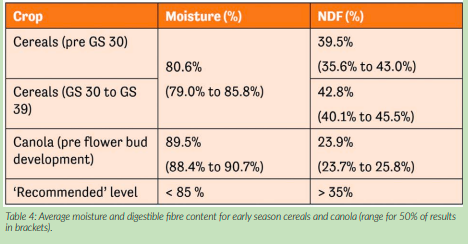
Currently there is no Australian standard for the amount of fibre to be fed to ruminants, however practical recommendations are that dairy cows require above 35% NDF to avoid reduction in milk fat.
Water Most water absorption in a ruminant occurs in the third stomach (the omasum) and the large intestine. The removal of water ‘hardens’ the excreted material. In diets with high moisture content, the animal is unable to absorb sufficient water to prevent loose faeces and appear to have ‘runny bums’. There is no benchmark for the maximum amount of water to prevent loose faeces although moisture contents above 85% are often observed to be threshold.
Winter crops in the early vegetative stage of growth are commonly low in fibre and high in moisture (table 4). Scouring may also be caused by a rapid change in diet, where the animal has not become accustomed to the different quality feed. The simplest way to minimise the potential scouring effect is to provide roughage just before entry to the crop and maintain access to this material during grazing. Late pregnant or lactating cows, or ewes, especially need good quality hay. Additional actions can include introducing stock to the type of feed over a three or four day period or only graze late in the afternoon for the first few days (to avoid potential nitrate poisoning). Always avoid turning hungry stock into a crop on an empty stomach.
Minerals
Work conducted by Hugh Dove, former Chief Research Scientist with CSIRO Plant Industry in Canberra identified that low magnesium was present in wheat crops. Acute magnesium deficiencies result in grass tetany, however more marginal deficiencies present themselves as lower than expected growth rates. The cause of the magnesium deficiency is an imbalance of potassium and sodium in the cereal the animals are grazing. Excess potassium combined with low sodium reduces the absorption of magnesium in the rumen. This deficiency can be easily rectified with a simple mineral lick. Sheep only need 20g/d and cattle 150 g/day.
Metabolic disorders
Canola can pose a greater risk to animal health than cereals, but this usually occurs when animals are suddenly introduced to the crop, often combined with conditions that make the crop stressed such as a lack of moisture, frost or herbicide application. The potential animal health problems include pneumonia, gastroenteritis, hypocalcemia, polio, liver damage, photosensitisation and nitrate poisoning. Stock should be fully vaccinated against enterotoxaemia before grazing. The recommendation when grazing canola is to offer hay and observe the animals closely for at least the first two weeks of grazing.
Crop diseases
The anecdotal information on diseases in cereal crops is quite variable. Some farmers believe grazing reduces disease such as rust by removing the diseased leaves and therefore the source of ongoing infection, or by reducing the canopy which improves air circulation and creates a less favourable condition for disease build up.
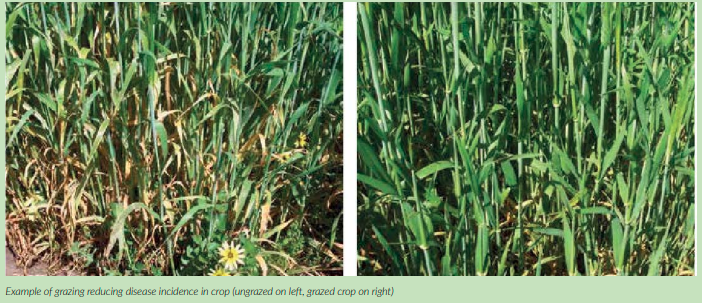
There is limited information on the effect of grazing on disease incidence. Observations of stripe and leaf rust in two barley and four wheat varieties in South West Victoria revealed no significant difference in rust incidence in the grazed and ungrazed plots, although the observations were taken during a drought year where the rust incidence was extremely low. In contrast a trial in Western Australia on barley where powdery mildew was about threshold control levels early in the season showed a substantial reduction in disease incidence until later in the season.
-
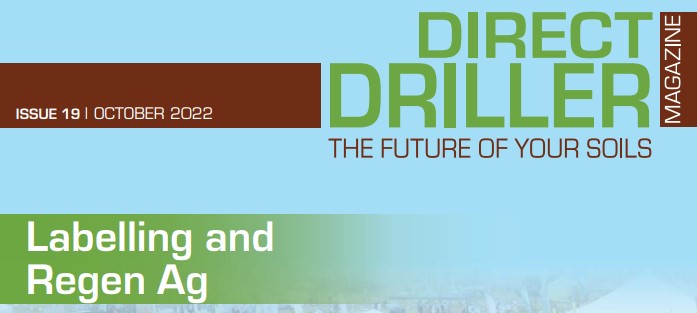
Introduction – Issue 19 – October 2022
Written by Mike Donovan
I have some sympathy for the new Defra Secretary Ranil Jayawardena. He got the job on Sept 6 and before the month was out was facing questions over ELMS – the greatest change in UK farming since the 1947 Agriculture Act. Ranil’s knowledge of farming is scant and he was surely hoping for time to bone up on the huge industry he now heads. Farming, environment, water and nature do not feature in his CV!
The growing financial crisis of the new government makes a re-think of ELMS look increasingly probable, and Minister Jayawardena will be lobbied from all sides. Government will question the benefits of farm subsidy. The NFU is not happy with present arrangements. Minette Batters wants the scheme delayed, saying “We called for a delay … because we believe that the SFI [part of ELMS] needed to have more detail and it needs to be profitable. We have always been calling for a better policy, one that does deliver for food production and for the environment.” Pro-ecology NFU members threaten to leave while Batters supporters want area payments to continue.
On Sept 26 a Defra spokeswoman explained that, while environmental land management remained important, the department was reviewing its plans “given the pressures on farmers, and the government’s aims of boosting food security and economic growth”. With the economy haemorrhaging as it is she could easily be referring to the UK economy rather than farmers.
She added: “In the light of the current global economic situation, we know that the cost of inputs has gone up, which might make it more difficult for farmers to both improve the natural environment and underpin food production, so we will continue our engagement with the sector to make sure the outcomes that the British people want to see are delivered.”
Given the current dismal national financial scene it looks very much as if ELMS will be on the back burner for some time with a distinct possibility of a cut in overall farm payments.
Direct Driller readers know conventional cultivation methods are from the Steam Age and farming is moving quickly to a period of biology and working with nature. Yet the lobbying power of ‘old ag’ remains considerable and Mr Jayawardene will need rapid education into the costs, benefits and needs of the new biological farmer. First among this is trials and advice, which is where Direct Driller (and Practical Farm Ideas) can play a part. Read this issue of Direct Driller and you will find a dozen and more vital areas of research, many being tackled by individual farmers.
Finally, I sincerely thank all who have contributed, and invite others to do the same.
-
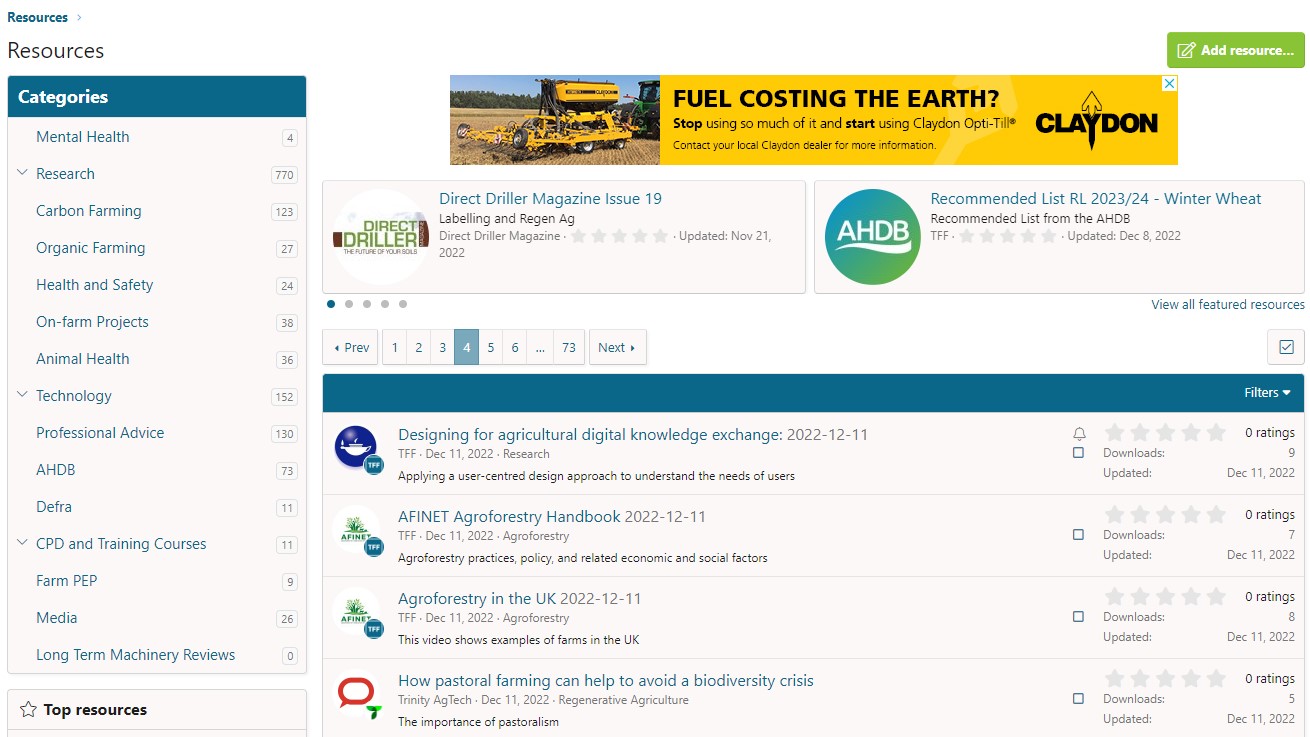
Reading more
Written by Chris Fellows
We have recently taken part in an Innovate UK competition to try and encourage farmers to read from formal material. Trial results, papers, research, on-farm projects and so forth. The assumption being that farmers who are better informed, make better decisions and thus become more profitable or sustainable (or both hopefully). This same aim being the reason behind this magazine and Groundswell starting at the same time. We wanted to give farmers a view on farming knowledge that wasn’t available through conventional sources. This concept was also peer reviewed in a paper by Sumane et al (2018). Farmers who read more information from more sources are more resilient.
Has been an interesting exercise. Some great ideas, like how to integrate video content into this knowledge exchange process, which we already do in Resources on The Farming Forum. It is hard to link contextually without a transcript of the video. This really makes you think about the overall KE landscape when faced with a problem.
As part of the process, we built TFF Resources to test how we could put formal and informal content on the same site and test ways to present and promote it. The first think to note is that TFF Resources now contains over 1200 pieces of knowledge. We have included many around the regen and conversation ag topics. Its has also in the last 4 months generated over 150,000 reads of this content organically. We intend to increase this to over 10,000 knowledge pieces over the next few years and create a library of information. But the real challenge is how you help farmers navigate that information and “suggest” what to read next. That is, the content that they will find most interesting and relevant. We don’t have all the answers right now, but a solution will help farming as a whole and balance some of the commercial bias that sits behind so much of the knowledge we currently read.
Have a look at the TFF Resources sections and see what you can find of interest: https://thefarmingforum.co.uk/index.php?resources/

-
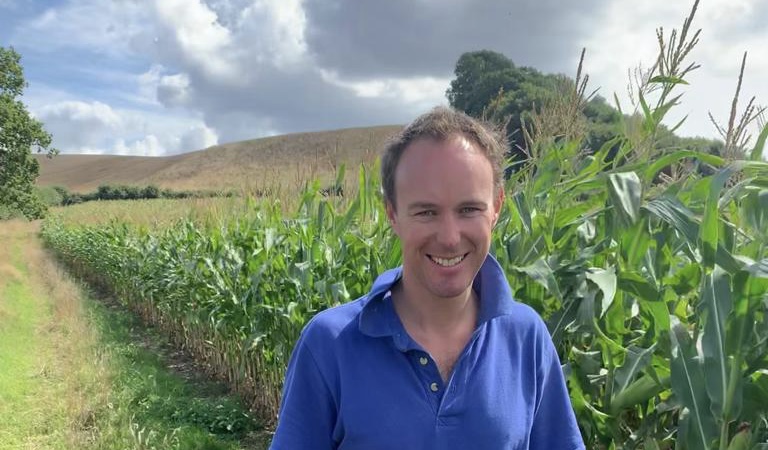
Featured Farmer – John Farrington
Farm Facts
245 Ha plus 40 Ha Woodland
Arable, Sheep and Diversification
Crops: Wheat OSR Oats Maize Spring Beans Miscanthus
Rainfall: 850-900mm average. Last 3 years 1200mm.
Soils: Sandy Loam, “Hungry” Soil, Low CEC and Low OM
In the time I have been a reader of Direct Driller Magazine, I have learnt a lot from the magazine’s content. While at the fantastic Groundswell event, Chris Fellows persuaded me to write a contribution to the magazine, which I am more than happy to do to give something back, so here is my roller coaster ride so far. I farm in partnership with my brother, Charlie, based in West Somerset. My father had got out of beef in 1999, contractors had been doing the majority of the arable work, and the grassland was rented out to neighbouring livestock farmers while he concentrated his efforts on old farm building renovations.
When I came back to the farm I gradually took operations back in hand and set about trying to improve the farming system. No disrespect to my father, but the soils had been overworked and under loved. The plough was used up until 2000, then a “min till” approach was taken with a tine and disc machine. Stubble was worked soon after harvest to get a chit and again before a contractors Vaderstad Rapid did the drilling, by the time it had been rolled it was like a sandy beach. At the time It all looked lovely and a perfect seed bed, but often the weather that followed was the down fall of the system. The autumn rain came and capped the surface, and the wheelings of the drill were there to be seen all year on the headlands.

We had to change something.
Not having any FYM on the farm, I used sewage sludge from Wessex water for a number of years, but I stopped using it 3 years ago, concerned about the long-term effects of the chemical based cleaning products that go down the kitchen / bathroom waste pipes. I did use green waste compost for a few years, a combination of haulage costs and plastic in the compost put a stop to this. I decided to chop all straw to help put some goodness back into the soil.
Being blackgrass free, I was concerned about balers bringing it onto the farm, it can be found locally. But chopping straw has had a knock-on effect when establishing cover crops and OSR in a direct drill scenario. To help the process I wanted to grow cover crops and go down the direct drilling route. I found a 2nd hand 4m Horsch Sprinter that our 150hp copes with on our hills. The Horsch duetts were removed and 4” Bourgault coulters fitted and ran them for 3/4 years. I now also have a set of 2” Bourgault. The 4” generally do cover crops and forage crops for sheep and the 2” do everything else.
I have been really pleased with both sets of points and their low disturbance. Now all crops are direct drilled. We have also done some targeted subsoiling. Crops are certainly looking a lot more even across the field and right out to the edge of the field since we have reduced cultivations. Cover crops have been grown for a number of years, usually consisting of phacelia, vetch, radish, berseem clover, bought as straights and mixed on farm. Costing around £25/Ha. These were grazed during the winter by a neighbour but now we have more control as our sheep graze the covers.
Catch crops are grown when timing allows. Another trigger for my change in thinking, was taking part in AHDB benchmarking and seeing my chemical costs £40/ Ha higher that the group average, being a lower yielding farm than the group this was a concern (wheat average 8.6T/Ha). I was wanting to implement some changes (that we have now done) but I was not getting the support from my agronomist, so I made the change to an Independent who was on the same line of thought as myself, and this has been a breath of fresh air.
Insecticides have not been used on the farm for about 4 years, we are trying to build up natural predators within and around the field. BYDV has not been anymore of a problem than it used to be when using insecticides, other than one field which had a spring/summer cover crop mix which included oats, the wheat was drilled into this on the green and we had a problem with “green bridge” carryover. I have stopped using all seed dressings and the home saved seed is tested for disease.
In Autumn 2019 we had 2 part fields of OSR and Wheat which we wrote off and used the failure as an opportunity in the spring to put in some small leaved white clover as an understorey in the following wheat crop. This was grazed twice over the summer. Our Sprinter drill wouldn’t cope with drilling into the clover so Horizon Agriculture came with their DSX drilling wheat into 4” tall wet clover after 16mm of rain overnight. This was an impressive machine, did a fantastic job, and the wheat looked the best on the farm right up until late May. Nutrition was used instead of fungicides, no pgr and only 125kg N.
It combined easily leaving a clover understorey for the sheep to graze a few weeks after harvest. The yield was disappointing at 6.2T/Ha, after how good the crop looked. This was mainly due to the low rate of N. We had hoped the clover would nodulate and provide some N to the growing crop but this did not happen due to the cold spring and the clover using the artificial N rather than producing its own. The winter oats following the wheat/clover looked greener all season where the clover had been and yielded higher than the rest of the field, but the clover ended up being sprayed out with a communication error from myself.
The other part field of clover was going into its 2nd year with 2nd wheat, we had to spray the clover off as too many grass weeds were present even after glyphosate and hard grazing before drilling. I see clover being used somewhere in the rotation but it is a challenge to keep grass weeds out with just glyphosate between crops. I need to try it again. I wish I could justify the Horizon DSX as it was a fantastic product, instead I fitted a set of front cutting discs to run in line with each leg onto my Sprinter. This has been great for cutting through trash and reducing soil disturbance from the coulter.
We always used to be a 4 spray fungicide programme whatever the weather, we now react to the crop/season and try to use more nutrition and less fungicides. Nitrogen has always been 220kg for wheat and we have started to reduce this over the last few years. This year we were at 170kg, Last year we tried to reduce N too quickly and by too much in a few fields and it did show up. I feel it needs to be reduced in small increments each year. We moved to liquid fertiliser 2 seasons ago, to help with the accuracy around the headlands on our small fields (average 10 acre), a carbon source of fulvic and humic acids are added to the liquid fertiliser.

In September 2021 we bought our own flock of 500 Exlana breeding ewes onto the farm, forage based, lambing outdoors. Sheep was totally new to us, but it hasn’t been a disaster in our 1st season !! This was to make better use of the grassland that had been rented out and have better control of the sheep when grazing cover crops and winter cereals and to bring livestock and some muck back onto the farm. I get reminded that I said “ I would never be a livestock farmer.” We have survived year one… As a trail – A cover crop was planted in August 2021 after oats, volunteer oats sprayed out, but no glyphosate, Wheat was direct drilled into this in October, with sheep grazing for a week after drilling. Wheat and cover crop continued to grow together with sheep grazing it again in Jan/Feb.
The cover crop was then sprayed out in early March. The wheat yield was a little lower, but this is also the lightest field on the farm so the drought may have contributed. More trials needed. I have always been against renting ground out for maize/ p o t a t o e s and undoing all the soil improvements. But this year I planted strip till maize into cover crop. I am taking the financial risk and growing it for a neighbour so I chose the establishment technique. Currently looking good despite the drought, yet no plough/powerharrow was involved. Fingers crossed for a dry weather when the forager arrives.

I have waffled on for long enough now so In summary… We are learning all the time, got a long way to go, made mistakes and its certainly not all perfect. But we will continue down this route and keep learning. I think my neighbours probably think I’m a bit mad, but you can’t worry what they think, and hopefully I am one step ahead of where we may have to be in the future. My advice would be to get the right people around you to help you with the direction you want to go, if they don’t want to change then replace them. Try things out on a small scale, don’t feel you need to be spending lots of £££ on new DD drills or expensive cover crops mixes. There is no quick fix and there are many parts involved to get it right – It takes time and don’t expect things to change in one season. And finally a lot of it is certainly in the mind – if the mind won’t change it won’t work. Hope you all have a safe and successful harvest and autumn drilling campaign
-

Featured Farmer – John Farrington

Farm Facts
245 Ha plus 40 Ha Woodland Arable, Sheep and Diversification Crops: Wheat OSR Oats Maize Spring Beans Miscanthus Rainfall: 850-900mm average. Last 3 years 1200mm. Soils: Sandy Loam, “Hungry” Soil, Low CEC and Low OM
In the time I have been a reader of Direct Driller Magazine, I have learnt a lot from the magazine’s content. While at the fantastic Groundswell event, Chris Fellows persuaded me to write a contribution to the magazine, which I am more than happy to do to give something back, so here is my roller coaster ride so far. I farm in partnership with my brother, Charlie, based in West Somerset. My father had got out of beef in 1999, contractors had been doing the majority of the arable work, and the grassland was rented out to neighbouring livestock farmers while he concentrated his efforts on old farm building renovations.
When I came back to the farm I gradually took operations back in hand and set about trying to improve the farming system. No disrespect to my father, but the soils had been overworked and under loved. The plough was used up until 2000, then a “min till” approach was taken with a tine and disc machine. Stubble was worked soon after harvest to get a chit and again before a contractors Vaderstad Rapid did the drilling, by the time it had been rolled it was like a sandy beach. At the time It all looked lovely and a perfect seed bed, but often the weather that followed was the down fall of the system. The autumn rain came and capped the surface, and the wheelings of the drill were there to be seen all year on the headlands.
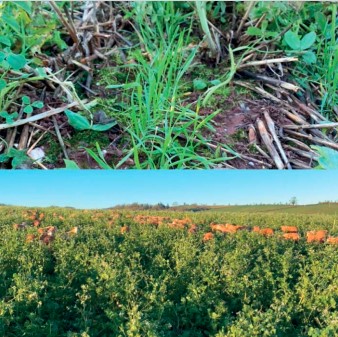
We had to change something.
Not having any FYM on the farm, I used sewage sludge from Wessex water for a number of years, but I stopped using it 3 years ago, concerned about the long-term effects of the chemical based cleaning products that go down the kitchen / bathroom waste pipes. I did use green waste compost for a few years, a combination of haulage costs and plastic in the compost put a stop to this. I decided to chop all straw to help put some goodness back into the soil. Being blackgrass free, I was concerned about balers bringing it onto the farm, it can be found locally. But chopping straw has had a knock-on effect when establishing cover crops and OSR in a direct drill scenario.

To help the process I wanted to grow cover crops and go down the direct drilling route. I found a 2nd hand 4m Horsch Sprinter that our 150hp copes with on our hills. The Horsch duetts were removed and 4” Bourgault coulters fitted and ran them for 3/4 years. I now also have a set of 2” Bourgault. The 4” generally do cover crops and forage crops for sheep and the 2” do everything else. I have been really pleased with both sets of points and their low disturbance. Now all crops are direct drilled. We have also done some targeted subsoiling. Crops are certainly looking a lot more even across the field and right out to the edge of the field since we have reduced cultivations. Cover crops have been grown for a number of years, usually consisting of phacelia, vetch, radish, berseem clover, bought as straights and mixed on farm. Costing around £25/Ha. These were grazed during the winter by a neighbour but now we have more control as our sheep graze the covers. Catch crops are grown when timing allows.
Another trigger for my change in thinking, was taking part in AHDB benchmarking and seeing my chemical costs £40/ Ha higher that the group average, being a lower yielding farm than the group this was a concern (wheat average 8.6T/Ha). I was wanting to implement some changes (that we have now done) but I was not getting the support from my agronomist, so I made the change to an Independent who was on the same line of thought as myself, and this has been a breath of fresh air.
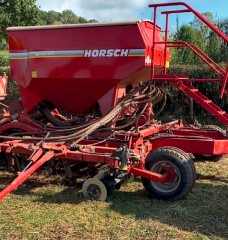
I n s e c t i c i d e s have not been used on the farm for about 4 years, we are trying to build up natural predators within and around the field. BYDV has not been anymore of a problem than it used to be when using insecticides, other than one field which had a spring/summer cover crop mix which included oats, the wheat was drilled into this on the green and we had a problem with “green bridge” carryover. I have stopped using all seed dressings and the home saved seed is tested for disease.
In Autumn 2019 we had 2 part fields of OSR and Wheat which we wrote off and used the failure as an opportunity in the spring to put in some small leaved white clover as an understorey in the following wheat crop. This was grazed twice over the summer. Our Sprinter drill wouldn’t cope with drilling into the clover so Horizon Agriculture came with their DSX drilling wheat into 4” tall wet clover after 16mm of rain overnight. This was an impressive machine, did a fantastic job, and the wheat looked the best on the farm right up until late May. Nutrition was used instead of fungicides, no pgr and only 125kg N. It combined easily leaving a clover understorey for the sheep to graze a few weeks after harvest. The yield was disappointing at 6.2T/Ha, after how good the crop looked.
This was mainly due to the low rate of N. We had hoped the clover would nodulate and provide some N to the growing crop but this did not happen due to the cold spring and the clover using the artificial N rather than producing its own. The winter oats following the wheat/clover looked greener all season where the clover had been and yielded higher than the rest of the field, but the clover ended up being sprayed out with a communication error from myself. The other part field of clover was going into its 2nd year with 2nd wheat, we had to spray the clover off as too many grass weeds were present even after glyphosate and hard grazing before drilling. I see clover being used somewhere in the rotation but it is a challenge to keep grass weeds out with just glyphosate between crops. I need to try it again.
I wish I could justify the Horizon DSX as it was a fantastic product, instead I fitted a set of front cutting discs to run in line with each leg onto my Sprinter. This has been great for cutting through trash and reducing soil disturbance from the coulter. We always used to be a 4 spray fungicide programme whatever the weather, we now react to the crop/season and try to use more nutrition and less fungicides. Nitrogen has always been 220kg for wheat and we have started to reduce this over the last few years. This year we were at 170kg, Last year we tried to reduce N too quickly and by too much in a few fields and it did show up. I feel it needs to be reduced in small increments each year. We moved to liquid fertiliser 2 seasons ago, to help with the accuracy around the headlands on our small fields (average 10 acre), a carbon source of fulvic and humic acids are added to the liquid fertiliser.
In September 2021 we bought our own flock of 500 Exlana breeding ewes onto the farm, forage based, lambing outdoors. Sheep was totally new to us, but it hasn’t been a disaster in our 1st season !! This was to make better use of the grassland that had been rented out and have better control of the sheep when grazing cover crops and winter cereals and to bring livestock and some muck back onto the farm. I get reminded that I said “ I would never be a livestock farmer.” We have survived year one…
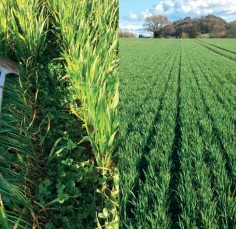
As a trail – A cover crop was planted in August 2021 after oats, volunteer oats sprayed out, but no glyphosate, Wheat was direct drilled into this in October, with sheep grazing for a week after drilling. Wheat and cover crop continued to grow together with sheep grazing it again in Jan/Feb. The cover crop was then sprayed out in early March. The wheat yield was a little lower, but this is also the lightest field on the farm so the drought may have contributed. More trials needed. I have always been against renting ground out for maize/ p o t a t o e s and undoing all the soil improvements. But this year I planted strip till maize into cover crop. I am taking the financial risk and growing it for a neighbour so I chose the establishment technique. Currently looking good despite the drought, yet no plough/powerharrow was involved. Fingers crossed for a dry weather when the forager arrives.
I have waffled on for long enough now so In summary… We are learning all the time, got a long way to go, made mistakes and its certainly not all perfect. But we will continue down this route and keep learning. I think my neighbours probably think I’m a bit mad, but you can’t worry what they think, and hopefully I am one step ahead of where we may have to be in the future.
My advice would be to get the right people around you to help you with the direction you want to go, if they don’t want to change then replace them. Try things out on a small scale, don’t feel you need to be spending lots of £££ on new DD drills or expensive cover crops mixes. There is no quick fix and there are many parts involved to get it right – It takes time and don’t expect things to change in one season. And finally a lot of it is certainly in the mind – if the mind won’t change it won’t work. Hope you all have a safe and successful harvest and autumn drilling campaign.
-
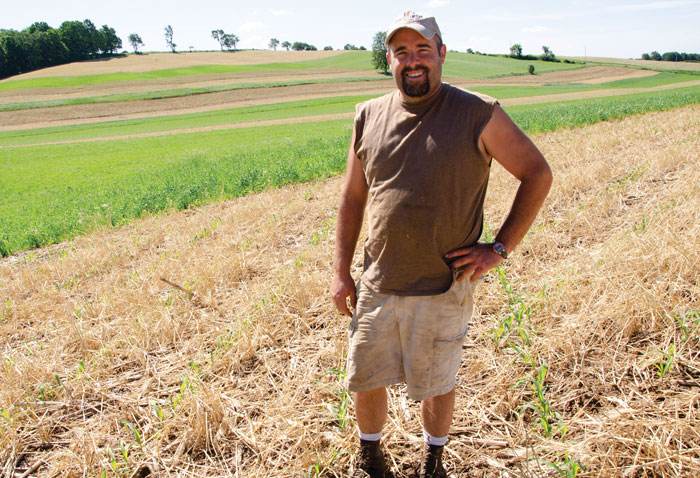
No-Till Innovation Come in Leaps and Bounds
By Brian O’Connor originally published by No-Till Farming
Wisconsin no-till dairyman Chris Conley thwarts heavy rain and hills with no-till, covers and planting green.
No-tiller Chris Conley took two big steps where other farmers might take one.
Conley farms 120 acres for feed (silages, dry hay and high-moisture corn) for his 52-cow dairy, located down a dirt road amid a small fold of hills in Dodge County. The hills make for stunning views of the surrounding countryside, and his barn and silo. They also pose unique management challenges. Or they did, until recently.
Up until 2018, Conley worked his hilly land using methods that had been handed down to him by his grandparents. They involved chisel plowing to make the land suitable for planting.
“It’s just how I learned how to do it,” he says. “That’s how it was supposed to be done, and I never thought to question it at all.”
At the same time, the hills limited his options. Plow in too deep, expose too much soil, and the hillside could alternately wash away and then dry out.
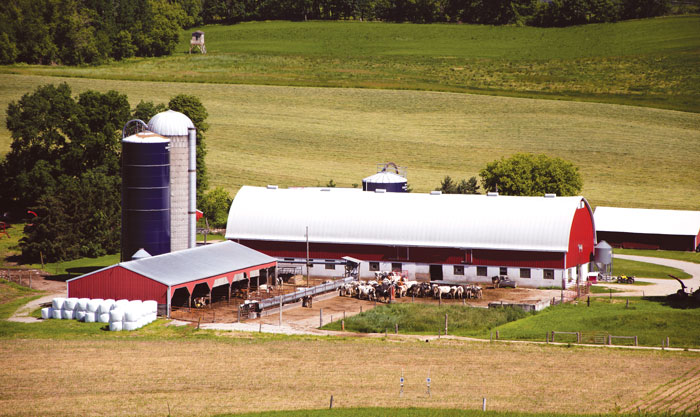
“They dry out so fast, so it’s nice to keep the ground covered, to help the water infiltrate in and protect the soil,” he says. “Fertilizer doesn’t mean anything if you don’t have water. Water’s the number one ingredient that you need for growing a crop.”
He couldn’t see No-till would work
The Dodge County Farmers for Healthy Soil & Healthy Water — a farmer-led peer group in the county Conley lives in — started up in about 2017, and Conley remembers being deeply skeptical about no-till. He avoided attending the meetings at first.
“There’s no way I’m going to this because this sounds bogus and I don’t foresee this (no-till) ever working,” he remembers telling a friend who was encouraging him to attend the meetings.
However, the friend persisted. After consulting with his wife, Conley went to a meeting. At the meeting, he saw Ray Archuleta’s rainfall simulation demonstration, where water is sprinkled over trays containing no-till and tilled soils. For those who haven’t seen it, the water moves rapidly through the no-till soil but tends to pool on top of the tilled soil without going very deep and then it runs off, just like in an erosion event in the field.
“After I saw his rainfall simulator, it made me a believer that no-till can work,” he says.
However, the final straw was an episode of public television on the Gulf of Mexico’s hypoxic zone.
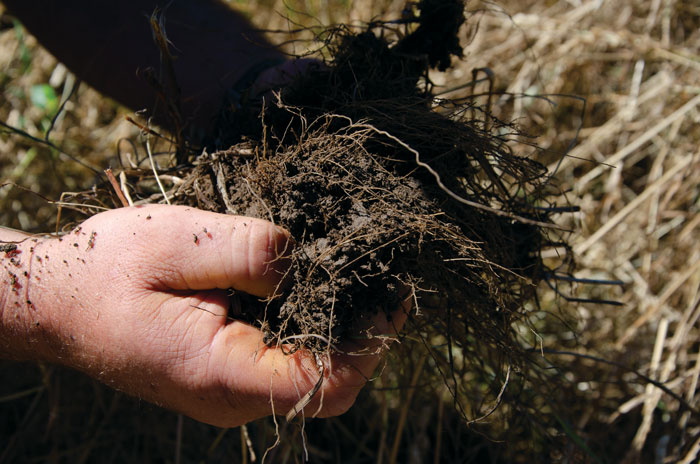
“There was a segment about fishermen in the Gulf of Mexico,” he says. “That’s a big point that really made me switch. They were talking about how all the nutrients and fertilizers are going into the watersheds here, then go into the Mississippi River and down to the Gulf of Mexico.”
Farm watercourse pollution was the deciding factor
The hypoxic zone means fishermen must travel further out into the gulf, into more dangerous waters, to catch the same number of fish. The idea bothered Conley’s working-class conscience.
“The way I look at it, we’re farmers of the land, and they’re farmers of the sea,” he says. “They have just as hard of a time making money as we do, so if we could do something to help them out down there, I think it’s a good thing.”
Conley flirted with no-till in 2017, planting a small field to test the results.
He jumped in with both feet in 2018. But not only did he switch all of his acres over to no-till, he took it a step further and planted it all green into a rye cover. He leaves about 20 acres of rye without corn to graze his dairy cows.
Conley doesn’t compare yields. Because his operation is focused on milk production, not food crops, he’s one step removed from the impacts of a bad season. At the same time, he has reduced labor and equipment maintenance expenses while maintaining profit.
And the soil on his hills stays in place, even under heavy rainfall.
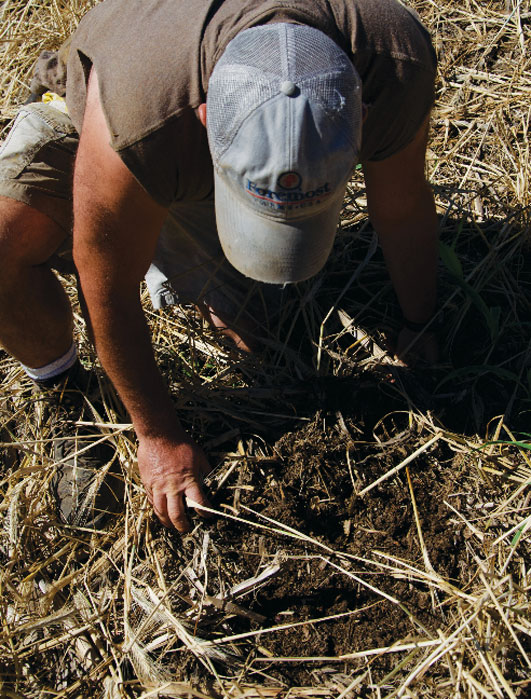
The Atari Planter
Conley’s first concern was whether he could no-till without forking over a hefty sum for a new planter. However, when he began his research online, he found numerous examples of farmers using older equipment, and the originators and proponents of no-till using their contemporary equipment to accomplish the same ends.
“They started out with John Deere planters, the same as what I have,” he says. “So I’m like ‘Well, if they started out with it, there’s no reason why I can’t use what I have.’”
More research turned up the fundamental similarities between today’s equipment and past equipment.
“The concept of putting a seed from the box to the ground is basically the same,” he says. “It’s just newer planters can go faster.
“If I can go slow and plant my crop with an old planter, I’m still money ahead because I’m not spending all that time in another tractor tilling and all that.”
Ultimately, Conley decided to go with his older planter, which he says resembles an Atari game console in its sophistication, but was good enough for his needs.
“My corn planter is a John Deere 7000 from the early 1980s,” he says. “The only thing on it is a light that tells if you’re planting or not planting.”
Conley added May Wes spiked closing wheels, Keeton seed firmers and Dawn row cleaners to his 4-row planter, which is on 36-inch spacing. He puts 50-pound sandbags in each of the planter’s insecticide boxes to increase the down force.
He went with second-hand modifications for economy’s sake.
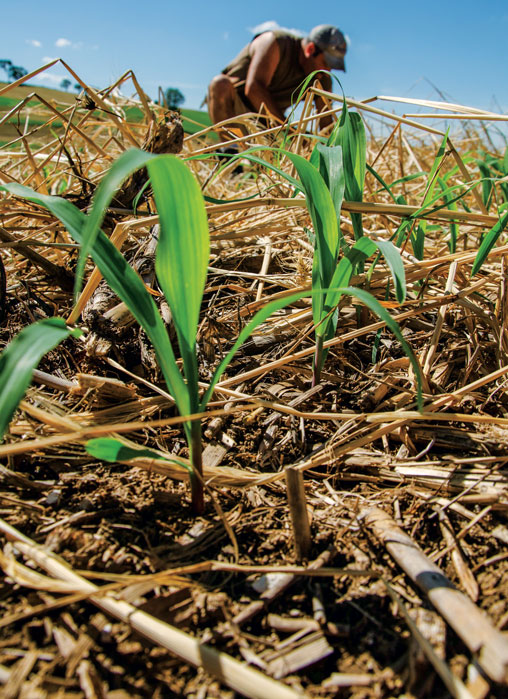
Despite the modifications and added weight, he says he would be comfortable pulling the planter with a 50-horsepower tractor, though he uses an 80-horsepower tractor for the work.
The next consideration was herbicides. Conley has his custom applied by the local co-op, which uses a blend of Roundup, Halex, atrazine and Dominance herbicides.
“I don’t know much about chemicals, and I trust their judgment on what there is for weeds and what you need for a burndown,” he says.
He’s looking into the possibility of eliminating herbicide as much as possible, and potentially using roller-crimping to terminate cover crops.
Planting green
“I’m not saying that I want to be organic,” he says. “I want to be able to keep the tool in the toolbox using herbicide.”
Conley had previously stopped using phosphorous (P) based on soil testing results. In 2022, he’s following a nutrient management plan, and testing showed he didn’t need any potassium (K), either.
Currently Conley uses 100 pounds of urea and 50 pounds of AMS with his planter. The starter nutrients are placed 4 inches away from the seed trench because he doesn’t have no-till fertilizer coulters. He broadcasts an additional 100 pounds of urea at the V5 growth stage, and continuously applies manure from his cows throughout the season.
For his planting green plans, in the third week of May he typically plants corn at a rate of 34,500 seeds per acre into a stand of living rye that had been seeded at a rate of 60 pounds per acre in October (though he has planted as late as Christmas Eve). He bumped the rate up to 100 pounds per acre in 2022.
He terminates his rye cover after planting.
While he’s used to the practices now, Conley admits no-till and planting green caused nerves as he launched his new methods.
“When I started this, there were a lot of sleepless nights. I thought ‘This is totally not supposed to be working,’” he says. “It was so weird. It was one of the most uncomfortable things I think I’ve ever done farming. But now I do it, I’m like ‘Oh, whatever.’ It’s normal.”
Observations
The Sand County Foundation installed two solar-powered soil probes in his rye field as part of a wider look at soil conditions in various tillage methods. When fall rolled around, Sand County officials reached out to get the probes removed, and Conley asked that they stay in place.
“I had talked to them and finally got them to keep them in because I felt that they were missing a crucial time of the year, over wintertime into spring, of seeing what the water cycle is,” he says.
That data will become especially important as winters become warmer.
The results of the study haven’t yet been released. Conley says he’s seen some data that validates his management decisions, such as more beneficial soil temperatures under cover crops.
“I’ve taken temperatures between two different types of soil — covered and uncovered — this spring, when the air temperature was 95 degrees,” he says. “The uncovered soil was 90 degrees and my soil underneath the manure and cover crop rye was 70 degrees.”
Those 20 degrees can be the difference between heat-sterilized biologically dead soil and biologically active soil in the summer months, Conley says and water infiltration has also improved.
Rain Man
Another data point came in torrents.
Heavy rains swept through southern Wisconsin on the afternoon of June 16, 2022, forcing motorists to temporarily shelter on the sides of Interstate highways. Flash flood warnings were issued for large parts of Dodge County, and other nearby counties.
At the hilly, scenic Conley farm, the rain gauge recorded more than 6.5 inches of rain. Nearby Hartford recorded 3 inches of rain that day, according to National Weather Service Records.
After the rain stopped, Conley and his daughter Mckayla went out to check whether the heavy rains had moved his crops. He saw some movement, but not from his plants.
“The other night, when we got that heavy rain, after we were done in the barn, me and Mckayla were looking out in the field,” he says. “There were millions of earthworms out there. When you took the flashlight, you could see the ground move.”
On a walking tour the next day, corn plants nestled in among heavy straw from his rye covers. On the small paths and headlands, where patches of some soil were visible, heavy rains had carved inch-deep canyons into exposed mud. The soil under the straw — and under a layer of manure below that — was damp but hadn’t moved.
“It’s looking good, I think,” he says, digging through residue. “How much better can you have soil covered than this?”



-
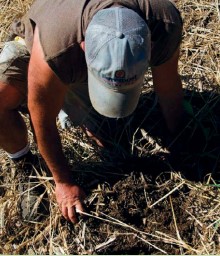
No-Till Innovation Comes In Leaps And Bounds
Wisconsin no-till dairyman Chris Conley thwarts heavy rain and hills with no-till, covers and planting green.
By Brian O’Connor originally published by No-Till FarmingNo-tiller Chris Conley took two big steps where other farmers might take one. Conley farms 120 acres for feed (silages, dry hay and high-moisture corn) for his 52-cow dairy, located down a dirt road amid a small fold of hills in Dodge County. The hills make for stunning views of the surrounding countryside, and his barn and silo. They also pose unique management challenges. Or they did, until recently.

Up until 2018, Conley worked his hilly land using methods that had been handed down to him by his grandparents. They involved chisel plowing to make the land suitable for planting. “It’s just how I learned how to do it,” he says. “That’s how it was supposed to be done, and I never thought to question it at all.” At the same time, the hills limited his options. Plow in too deep, expose too much soil, and the hillside could alternately wash away and then dry out.
“They dry out so fast, so it’s nice to keep the ground covered, to help the water infiltrate in and protect the soil,” he says. “Fertilizer doesn’t mean anything if you don’t have water. Water’s the number one ingredient that you need for growing a crop.”
Hill No
The Dodge County Farmers for Healthy Soil & Healthy Water — a farmer-led peer group in the county Conley lives in — started up in about 2017, and Conley remembers being deeply skeptical about no-till. He avoided attending the meetings at first. “There’s no way I’m going to this because this sounds bogus and I don’t foresee this (no-till) ever working,” he remembers telling a friend who was encouraging him to attend the meetings.
However, the friend persisted. After consulting with his wife, Conley went to a meeting. At the meeting, he saw Ray Archuleta’s rainfall simulation demonstration, where water is sprinkled over trays containing no-till and tilled soils. For those who haven’t seen it, the water moves rapidly through the notill soil but tends to pool on top of the tilled soil without going very deep and then it runs off, just like in an erosion event in the field.
“After I saw his rainfall simulator, it made me a believer that no-till can work,” he says.
However, the final straw was an episode of public television on the Gulf of Mexico’s hypoxic zone. “There was a segment about fishermen in the Gulf of Mexico,” he says. “That’s a big point that really made me switch. They were talking about how all the nutrients and fertilizers are going into the watersheds here, then go into the Mississippi River and down to the Gulf of Mexico.” The hypoxic zone means fishermen must travel further out into the gulf, into more dangerous waters, to catch the same number of fish. The idea bothered Conley’s working-class conscience.
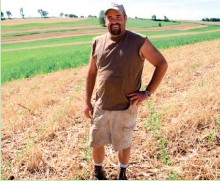
“The way I look at it, we’re farmers of the land, and they’re farmers of the sea,” he says. “They have just as hard of a time making money as we do, so if we could do something to help them out down there, I think it’s a good thing.”
Conley flirted with no-till in 2017, planting a small field to test the results. He jumped in with both feet in 2018. But not only did he switch all of his acres over to no-till, he took it a step further and planted it all green into a rye cover. He leaves about 20 acres of rye without corn to graze his dairy cows. Conley doesn’t compare yields. Because his operation is focused on milk production, not food crops, he’s one step removed from the impacts of a bad season. At the same time, he has reduced labor and equipment maintenance expenses while maintaining profit.
And the soil on his hills stays in place, even under heavy rainfall.
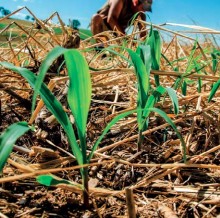
The Atari Planter
Conley’s first concern was whether he could no-till without forking over a hefty sum for a new planter. However, when he began his research online, he found numerous examples of farmers using older equipment, and the originators and proponents of no-till using their contemporary equipment to accomplish the same ends. “They started out with John Deere planters, the same as what I have,” he says. “So I’m like ‘Well, if they started out with it, there’s no reason why I can’t use what I have.’” More research turned up the fundamental similarities between today’s equipment and past equipment. “The concept of putting a seed from the box to the ground is basically the same,” he says. “It’s just newer planters can go faster.
“If I can go slow and plant my crop with an old planter, I’m still money ahead because I’m not spending all that time in another tractor tilling and all that.”
Ultimately, Conley decided to go with his older planter, which he says resembles an Atari game console in its sophistication, but was good enough for his needs. “My corn planter is a John Deere 7000 from the early 1980s,” he says. “The only thing on it is a light that tells if you’re planting or not planting.” Conley added May Wes spiked closing wheels, Keeton seed firmers and Dawn row cleaners to his 4-row planter, which is on 36-inch spacing. He puts 50-pound sandbags in each of the planter’s insecticide boxes to increase the down force.
He went with second-hand modifications for economy’s sake. Despite the modifications and added weight, he says he would be comfortable pulling the planter with a 50-horsepower tractor, though he uses an 80-horsepower tractor for the work. The next consideration was herbicides. Conley has his custom applied by the local co-op, which uses a blend of Roundup, Halex, atrazine and Dominance herbicides.
“I don’t know much about chemicals, and I trust their judgment on what there is for weeds and what you need for a burndown,” he says. He’s looking into the possibility of eliminating herbicide as much as possible, and potentially using rollercrimping to terminate cover crops. “I’m not saying that I want to be organic,” he says. “I want to be able to keep the tool in the toolbox using herbicide.”
Conley had previously stopped using phosphorous (P) based on soil testing results. In 2022, he’s following a nutrient management plan, and testing showed he didn’t need any potassium (K), either. Currently Conley uses 100 pounds of urea and 50 pounds of AMS with his planter. The starter nutrients are placed 4 inches away from the seed trench because he doesn’t have no-till fertilizer coulters. He broadcasts an additional 100 pounds of urea at the V5 growth stage, and continuously applies manure from his cows throughout the season.
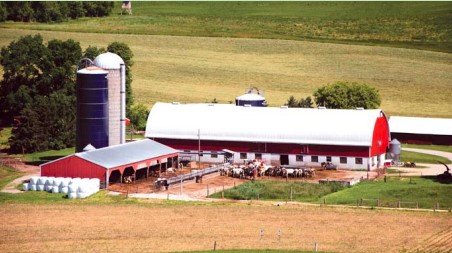
For his planting green plans, in the third week of May he typically plants corn at a rate of 34,500 seeds per acre into a stand of living rye that had been seeded at a rate of 60 pounds per acre in October (though he has planted as late as Christmas Eve). He bumped the rate up to 100 pounds per acre in 2022. He terminates his rye cover after planting. While he’s used to the practices now, Conley admits no-till and planting green caused nerves as he launched his new methods.
“When I started this, there were a lot of sleepless nights. I thought ‘This is totally not supposed to be working,’” he says. “It was so weird. It was one of the most uncomfortable things I think I’ve ever done farming. But now I do it, I’m like ‘Oh, whatever.’ It’s normal.”
Observations
The Sand County Foundation installed two solar-powered soil probes in his rye field as part of a wider look at soil conditions in various tillage methods. When fall rolled around, Sand County officials reached out to get the probes removed, and Conley asked that they stay in place.
“I had talked to them and finally got them to keep them in because I felt that they were missing a crucial time of the year, over wintertime into spring, of seeing what the water cycle is,” he says. That data will become especially important as winters become warmer. The results of the study haven’t yet been released. Conley says he’s seen some data that validates his management decisions, such as more beneficial soil temperatures under cover crops. “I’ve taken temperatures between two different types of soil — covered and uncovered — this spring, when the air temperature was 95 degrees,” he says. “The uncovered soil was 90 degrees and my soil underneath the manure and cover crop rye was 70 degrees.”
Those 20 degrees can be the difference between heat-sterilized biologically dead soil and biologically active soil in the summer months, Conley says. Water infiltration has also improved, Conley says.
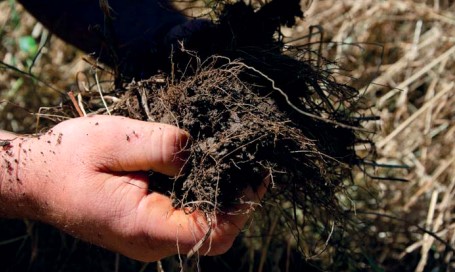
Rain Man
Another data point came in torrents. Heavy rains swept through southern Wisconsin on the afternoon of June 16, 2022, forcing motorists to temporarily shelter on the sides of Interstate highways. Flash flood warnings were issued for large parts of Dodge County, and other nearby counties. At the hilly, scenic Conley farm, the rain gauge recorded more than 6.5 inches of rain. Nearby Hartford recorded 3 inches of rain that day, according to National Weather Service Records. After the rain stopped, Conley and his daughter Mckayla went out to check whether the heavy rains had moved his crops. He saw some movement, but not from his plants.
“The other night, when we got that heavy rain, after we were done in the barn, me and Mckayla were looking out in the field,” he says. “There were millions of earthworms out there. When you took the flashlight, you could see the ground move.”
On a walking tour the next day, corn plants nestled in among heavy straw from his rye covers. On the small paths and headlands, where patches of some soil were visible, heavy rains had carved inch-deep canyons into exposed mud. The soil under the straw — and under a layer of manure below that — was damp but hadn’t moved.
“It’s looking good, I think,” he says, digging through residue. “How much better can you have soil covered than this?”
-
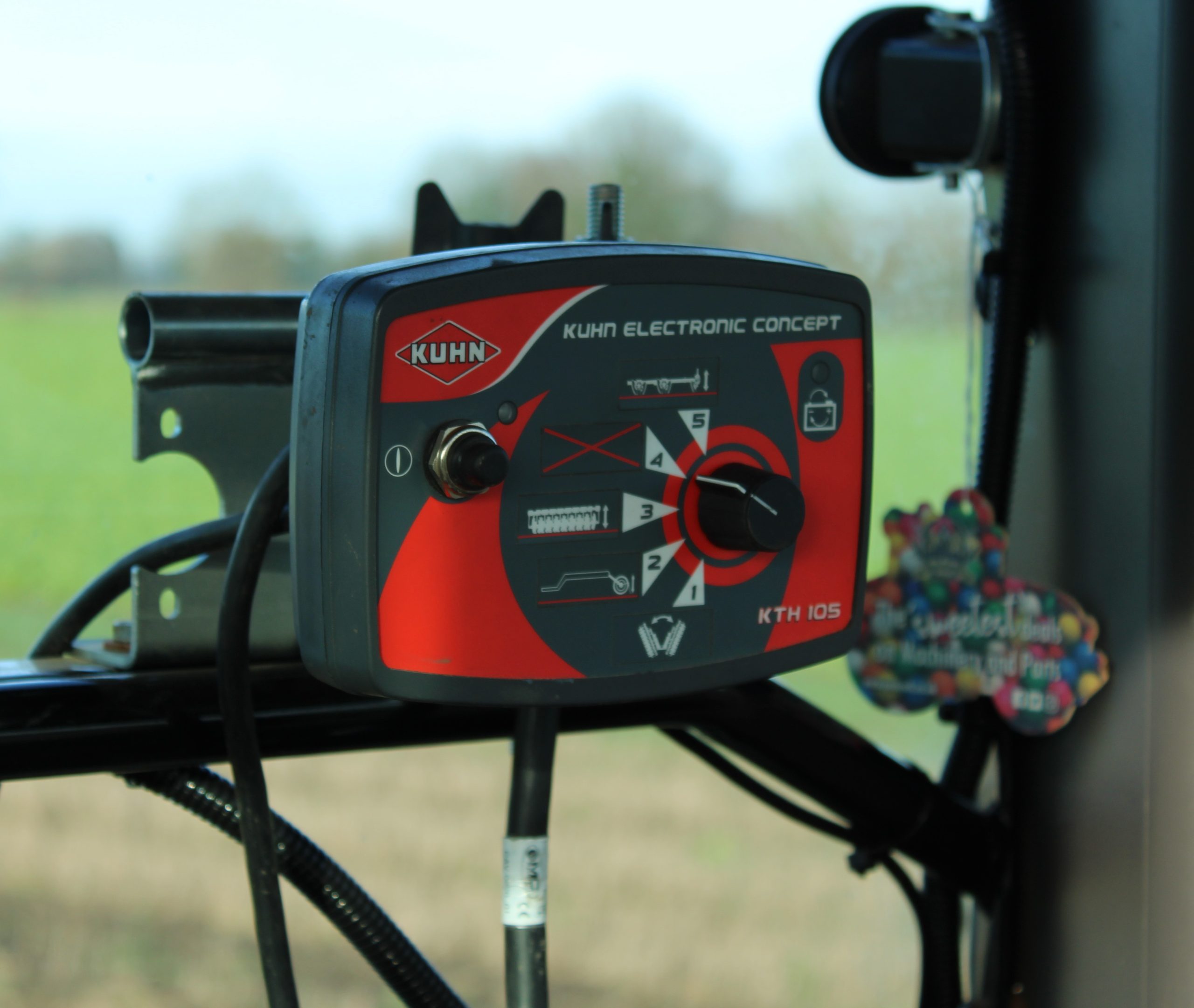
Kuhn’s Performer offers four levels of cultivation
The KUHN Performer is a deep cultivator, available in working widths from 3 to 7 metres, designed to prepare the soil for minimum tillage drilling. The Performer fulfils four cultivation tasks in one, by chopping, mixing, loosening, and levelling the soil in just one pass.
At the front of the machine there are two rows of hydraulically adjustable, 510mm cutting discs. The discs are capable of cutting through crop residues and root systems and can be used independently for stubble cultivation at depths of 10 centimetres, even at higher speeds.
The discs are followed by hydraulically pressured tines with options for 80mm standard points, 50mm carbide points with deflectors, or 80mm and 50mm carbide points. The carbide coating provides strength and durability, making the tine longer lasting. The tines can be adjusted to operate at depths of 5 to 35 centimetres, depending on the point chosen, to cover a wide variety of soil types.
Behind the running wheels, are four rows of tines set at equal widths that perform an in-depth mix, incorporating any residues and straw into the soil. Also available as standard on the Performer are 350mm carbide wings.
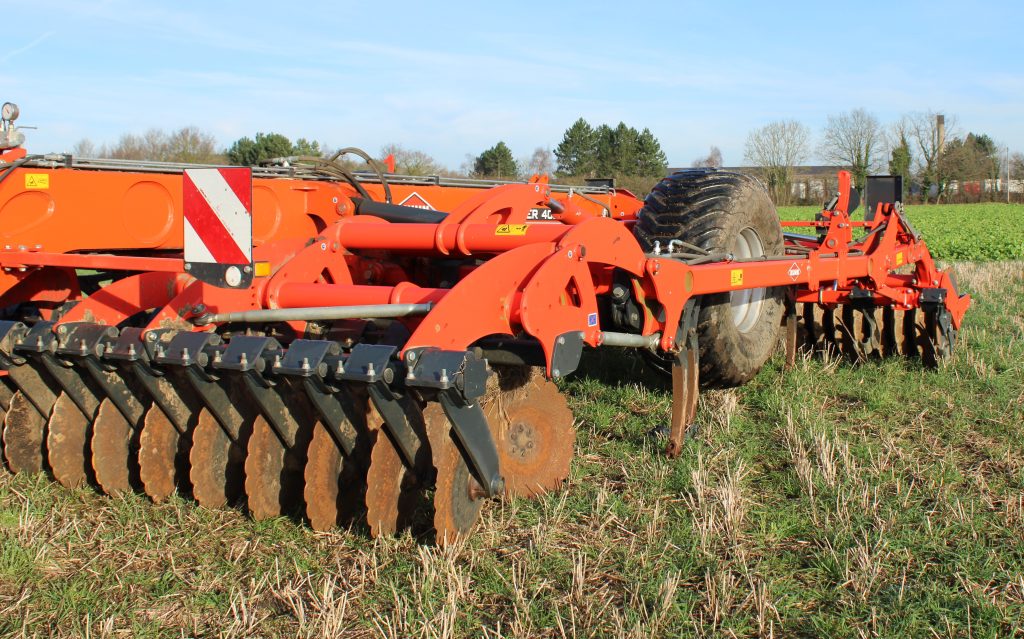
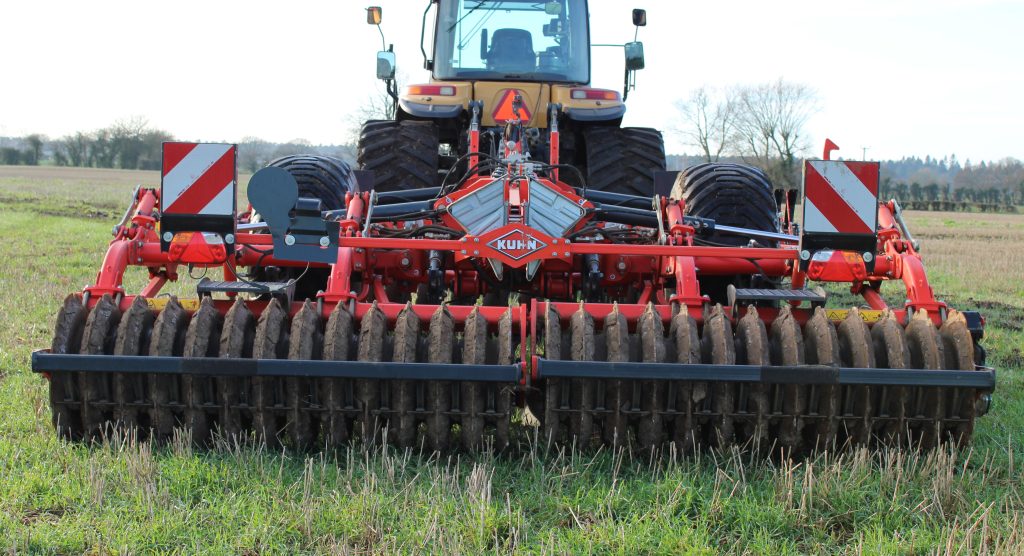
In addition, a single row of star shaped levelling discs provide a fine tilth. At the rear of the Performer is a double U-shaped packer or the option of an HD liner roller to roll the soil and leave an even finish.
All of the Performer’s functions are adjustable from within the cab using KUHN’s KTH 105 selector terminal which only requires one double acting valve for the axle and a single acting valve for the safety legs. The discs can be operated independently for stubble cultivation and the roller can be lifted and carried above the soil when not required.
The Performer range is designed for tractors with outputs of between 180 horsepower for the 3 metre machine and 420 horsepower for the 7 metre model. It also folds to less than 3 metres, making it ideal for tight gates and narrow lanes.
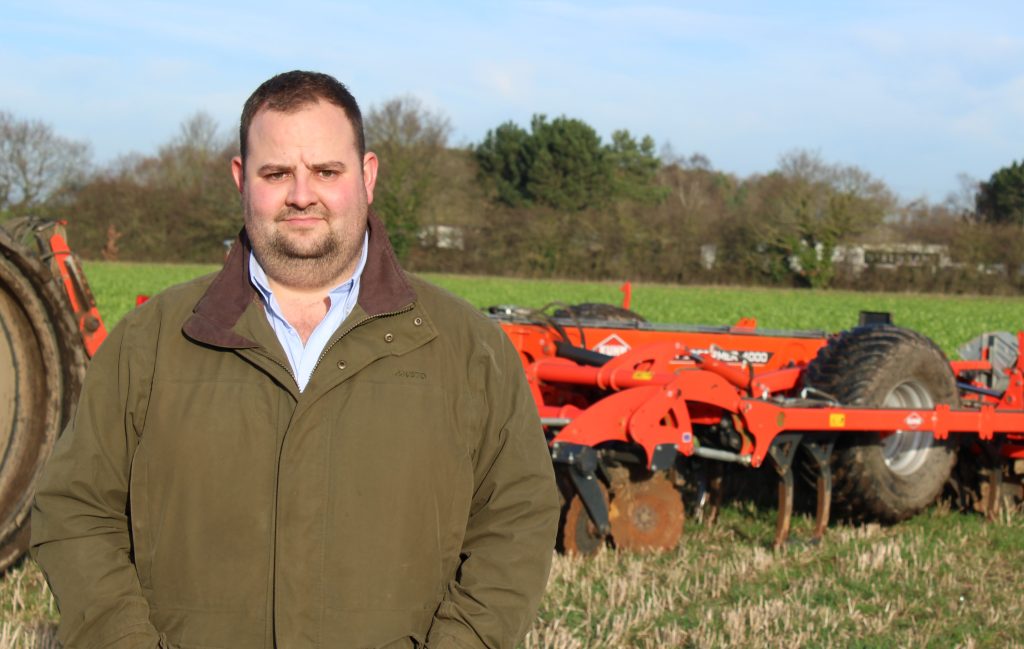
North Yorkshire arable farmer, Matt Harrison, bought a Performer 4000 for his family farm in Wistow, near Selby. It has become the primary cultivator for the 1500-acre farm following a decision to move away from a plough-based system. Mr Harrison said:
“I have been so grateful for the time savings the Performer has brought to the cultivation work on the farm. It is very easy to set up and requires far less maintenance than previous cultivators I have used. I don’t have to grease the legs and discs to prepare the machine, which means I can take advantage of every opportunity I get.”
This time and labour saving is due to the Performer having easy to change depth settings and fewer greasing points. “It also has a control box in the cab that makes life so much easier. Using just one spool I can control the whole machine and quickly make alterations for the changing land we have on the farm,” he added.
The machine is also helping to reduce the amount of fuel needed to prepare the land. When using a plough-based system his tractor could use 600 litres of fuel in a 10-hour day and only cover 30 acres. Whereas, with the Performer the same tractor can cover 60 acres using the same amount of fuel, which has halved is fuel cost. “We use a 2009 CAT Challenger. It is not the newest machine, but it is perfectly suited to the Performer and the cultivation work we do here. The fuel savings with a min-till system make a big difference. Especially with the recent rise in fuel costs,” he concluded.


-
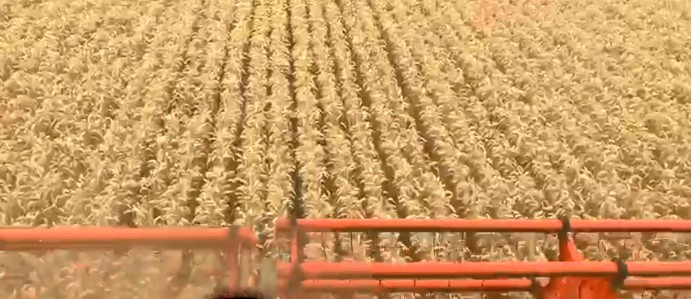
Another Extraordinary Year
What an extraordinary growing season we seem to have had. In a nutshell, very low rainfall, low temperatures until
June and good levels of solar radiation (sunshine) resulting in generally good yields with good specific weight and
moderate protein. Especially so as most crops senesced approximately 2 weeks earlier than normal.
Written by James Warne from Soil First Farming
All the more extraordinary is where we have, once again, been trialing reduced nitrogen rates on production we have seen very little difference in final yield between standard N rates and reduced N rates (until we reach a critical level, then yield drops significantly). Where we have found yield difference this comes from lower grain weight as opposed to reduced plant counts or tiller numbers.
So what can we draw from this wealth of variables? Firstly, autumn 2021 was the kindest drilling season we have had for a couple of years suggesting that most crops went into good soil conditions backing up the adage ‘well sown-half grown’! the autumn and winter that followed was certainly dryer and in some areas was probably below average on the rainfall scale suggesting that crops rooted well. Winter was also very mild with very few days of frost and certainly no prolonged periods of cold weather. Wheat tends to be growing at around 5’C and above and I believe that the crops were growing most of the winter, albeit very slowly probably contributing to root mass development as much as above ground vegetative growth.
Temperature
One of the greatest contributing factors in this year’s yield-fest has been the temperature, or rather lack of if we cast our minds back to the early spring and summer. For the majority of us the temperatures were in the comfortable mid to high teens (celcius) occasionally reaching the low 20’s but never exceeding this until mid-June. Contrary to popular belief high-temperatures can be one of the greatest yield reducing factors for wheat as it can be sensitive to high temperatures throughout its growth cycle. It is, however, particularly to heat during the period from booting, through ear-emergence and flowering. This sensitivity then reduces after flowering trough grain-fill and maturity. Research shows temperature effects can start from the mid-late 20’s and become significant once into the 30’s. This is particularly so during the period of pollen formation and fertilisation.
Typically wheat is in flower around the second wheat in June (assuming the midlands of the UK). This occurred 7-10 days earlier this around, early June. The first really warm temperatures occurred around the 15th June onwards this year. By which time wheat had passed through the temperature critical period of pollen formation and flowering. From then on the temperatures typically remained in the low 20’s throughout June and into July when the skies cleared and we had prolonged periods if high 20’s-30’s and clear skies. This warmth and sun, combined with large soil moisture deficits, lead to rapid senescence and ripening. But the critical period of reproductive growth (stem extension and ear formation through to flowering) occurred during steady consistent conditions. The high temperatures came too late to have any potential to reduce yield. Although those in the very dry east of the country probably found the lack of moisture contributed to a drop in yield.
Nitrogen
It is generally accepted that the crop only receives half its nitrogen requirement from that we apply. The other 50% comes from or via the soil. With the majority of the nitrogen being taken up in the nitrate form which is very water soluble it is assumed that the plant takes up most of its nitrogen as nitrate in the soil water.
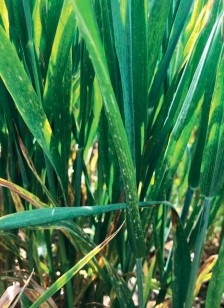
With the bulk of the uptake happening from stem extension through to ear emergence. As I have already mentioned above a large chunk of the UK was very dry during this period of April & May with some areas receiving zero rainfall, yet crops were still able to access the nitrogen they required for canopy and ear development. Although it seems perhaps not enough to assimilate into protein but that may also be attributed to sulphur availability. What is really interesting though is where we had reduced the soil applied N by half, combined with a small amount of foliar applied N this gave a very similar yield to wheat which had received a typical nitrogen dose.
Where we had dropped the soil applied N further we did start to see a yield drop. I must stress these results were consistent on farms which have been practicing carbonbuilding practices as in a Conservation Agriculture strategy, where we believe there to be a greater supply of N available for mineralization by the soil biology. Although another question must surely be if the soil was moisture deficient the biology must surely have been dormant and therefore unable to mineralise the nitrogen! It’s also worth noting that while it developed into another low disease year we saw a marked increase in mildew develop in the high N plots compared to lower total N plots. Never forget that nitrogen can help drive disease levels within the crop.
Finally, one of the most perplexing outcomes of this year is if the crop is able to produce the yields we have had when its growing cycle was at least two weeks shorter than average, why do we spend so much time and effort in trying to keep the canopy green? If there is one thing we have been shown this year it’s the lifespan of the crop has no direct influence on the final yield…..
-

Drill Manufacturers In Focus…
KUHN’S PERFORMER OFFERS FOUR LEVELS OF CULTIVATION

The KUHN Performer is a deep cultivator, available in working widths from 3 to 7 metres, designed to prepare the soil for minimum tillage drilling. The Performer fulfils four cultivation tasks in one, by chopping, mixing, loosening, and levelling the soil in just one pass.
At the front of the machine there are two rows of hydraulically adjustable, 510mm cutting discs. The discs are capable of cutting through crop residues and root systems and can be used independently for stubble cultivation at depths of 10 centimetres, even at higher speeds. The discs are followed by hydraulically pressured tines with options for 80mm standard points, 50mm carbide points with deflectors, or 80mm and 50mm carbide points. The carbide coating provides strength and durability, making the tine longer lasting. The tines can be adjusted to operate at depths of 5 to 35 centimetres, depending on the point chosen, to cover a wide variety of soil types.
Behind the running wheels, are four rows of tines set at equal widths that perform an in-depth mix, incorporating any residues and straw into the soil. Also available as standard on the Performer are 350mm carbide wings.

In addition, a single row of star shaped levelling discs provide a fine tilth. At the rear of the Performer is a double U-shaped packer or the option of an HD liner roller to roll the soil and leave an even finish.
All of the Performer’s functions are adjustable from within the cab using KUHN’s KTH 105 selector terminal which only requires one double acting valve for the axle and a single acting valve for the safety legs. The discs can be operated independently for stubble cultivation and the roller can be lifted and carried above the soil when not required.
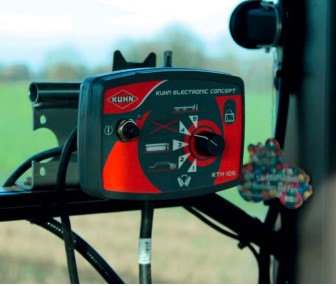
The Performer range is designed for tractors with outputs of between 180 horsepower for the 3 metre machine and 420 horsepower for the 7 metre model. It also folds to less than 3 metres, making it ideal for tight gates and narrow lanes.

-

Wye oh Wye…?
Wye oh Wye…?
The River Wye intertwines the border of England and-Wales. Once the nations “favourite” river it now probably has more designations than actual fish and continues to regularly feature in the media as the poster girl for agricultural pollution. In this article I hope to provide some insights in the complexities behind the headlines.

Photo: 1 River Wye from Symonds Yat Why the Wye? It is designated as a Special Area of Conservation (SAC) and a Site of Special Scientific Interest (SSSI), it contains an Area of Outstanding National Beauty (AONB), Nitrate Vulnerable Zones (NVZ) and Drinking Water Safeguarding Zones (DWSQZ) yet none of these protections have prevented its deterioration. SAC rivers have to meet tighter water quality targets to, in theory, protect their sensitive and rare ecology. So the Wye along with about fourteen other SAC rivers in the UK are trying to metaphorically tighten their belts much more than others.
Is it as green as they say? Algal blooms are caused by a combination of factors, including periods of warm sunny weather and low flows. However when these conditions are combined with a source of nutrients, and in particular phosphorus which acts the same in water as it does in soil, it fuels algae growth.
Algal blooms have occurred for decades in the lower reaches of the Wye and are generally attributed to soil and nutrient losses as a result of decades of reasonably intensive agricultural production in Herefordshire, we’re an innovative and industrious lot. However algal blooms are now also occurring in minor tributaries way up in the catchment, which indicates that the pattern of nutrient loss is changing and becoming more widespread.
Thick algal blooms can have severe effects on the river’s ecology. By discolouring the water, essential sunlight is prevented from reaching plants like our precious river crowfoot (ranunculus). Plants play a vital role in the river’s ecology, providing food and habitat for a range of invertebrate, fish and bird species.

Photo: 2 Left: The Wye at Bridge Sollers, a few miles upstream of Hereford, in July 2013 showing clear water and extensive beds of ranunculus. Right: Same location in June 2020 with the green tinge of an algal bloom and a significant reduction in ranunculus. So where is it all coming from? The predominant cause of pollution historically in the Wye was due to the poor quality of sewage treatment, however investment over the decades has improved this significantly and source apportionment indicates that Welsh Water are now responsible for only 25-30% of the nutrients in the river. On the other hand, agriculture as an industry is responsible for the lions share at 60-65%.
If you stand behind the “its not us Guv” rhetoric of the farming unions, or simply have no faith in our Government and their statutory bodies to undertake their roles effectively (more on that later!), you may question the datasets and dispute these figures. So let me assure you that the same if worse conclusion was also reached by a team of independent researchers at Lancaster University. After a three year study called “REPHOKUS” the Lancaster team have provided significant insight in to the root cause of the Wye’s green waters, detailing how the phosphorus (P) burden in the catchment accumulates and how losses are compounded by our circumstances. Their conclusion was that agriculture accounted for 70% of the P load and that we were accumulating an excess of approximately 3000t of P every year in the Wye.
Why all the chat about chickens? The REPHOKUS project identified the largest import of P into the catchment as livestock feed (ca. 5000 t P/ yr), nearly 80% of this is attributed to poultry sector, then 18% to cattle and sheep, and 2% to pigs. Fertiliser P imports to the catchment are just over 1000 t yr. From Sun Valley in the 1960s, to Cargill and subsequently Avara, Herefordshire has long been a major producer of broiler chicken. And with the move from cages, a significant number of free range sites have been established to keep up with consumer demand. We are indeed, for want of a better word, a hotspot. The figures thrown around are 20million birds, but no one yet has been able or willing to calculate the exact number. The fact that its chickens we have a lot of is neither here nor there; a lot of anything isn’t good for you.
I alluded to compounding circumstances earlier; the Wye soils are predominantly sandy and silty so are less able to hold on to nutrients, they are “leaky”. And despite what I was taught, P can be lost in solution like N. Once the soils capacity to hold nutrients is exceeded, which for much of the Wye soils appears to be anything above a P Index of 2, it can be lost in soil pore water and starts coming out in the drains. And having an excess of 3000t P every year for quite some time means that we have been building our P indices fairly rapidly.
And there you have it, the perfect storm; an ecologically sensitive river, leaky soils and an intensively farmed catchment with a huge excess of Phosphorus.

Photo: 3 Environment Agency Source Apportionment for the Wye Who the heck am I anyway? I grew up in Herefordshire, in the nutrient rich fields of my family’s dairy farm for the sake of transparency, a love for rivers sparked way back in school Geography lessons which led me to spend my working life to date trying to improve their condition. (Early retirement looking less and less likely!)
Desperate to learn about how other countries had used finances, education and regulation to address issues with soil and water I applied for a Nuffield Farming Scholarship in 2015. My studies allowed me to see regulatory approaches, funding models, voluntary and educational programmes around the world. I rapidly came to the conclusion that no single mechanism, if implemented alone, could achieve the long-term positive change we needed. There is a sweet spot somewhere in the middle and in the 7 years since my scholarship we still haven’t managed to secure it in the Wye…
What’s actually being done? With my team of advisers at The Wye & Usk Foundation, a charitable rivers trust, we provide support to about 300 farm businesses a year. This work includes the submission of more than £20m worth of Countryside Stewardship Schemes in the last 4 years to help deliver the recommendations we make. In a normal year we hold about dozen on-farm events with local partners, plus provide facilitation for three farmer groups. These enable peer to peer learning, farmers learn best from farmers, those who have changed practices are best placed to explain what motivated them, how they overcame barriers, provide insight to their methods and moral support for others following suit.
Much effort has been put in to work more collaboratively between partners operating in the same space. The Farm Herefordshire partnership brings together NGOs like ourselves and Herefordshire Meadows with local delivery staff for the AHDB, Catchment Sensitive Farming and CLA to name but a few, to share resources and deliver more effectively together.
Through our Wye Agri Food Partnership, part of the wider Courtauld Commitment instigated by WRAP, we are delivering collaborative projects with key businesses sourcing or producing food in the Wye. With the support of the Rivers Trust and WWF our work in the Wye currently involves projects with Tesco, Coop, M&S, Muller, Avara, Noble Foods, Stonegate, Kepak and most of the major soft fruit growers. We are working proactively with these businesses to reduce pollution risk at all levels of their supply chains, see our Project Case Study as an example.
Several businesses are also independently exploring new technologies to enable the export of excess P from the catchment. If these are successful they could take our P load back in to balance, and ideally in to deficit so that we can start to run down the P backlog…
To do that we need a funding framework that facilitates farming within the limits of our environment. I hoped DEFRA would agree with this ambition and submitted an application to Landscape Recovery Scheme but it was unsuccessful. We now need to find alternative routes to deliver solutions.
Along with a significant number of like minded farmers, my vision is to develop long term funding streams that would support us in delivering two key actions: 1. Running down existing high P levels by farming at low or no P input on soils at high risk of losses, and 2. Construction of wetlands downstream of high P fields to buffer the nutrient losses in the meantime.
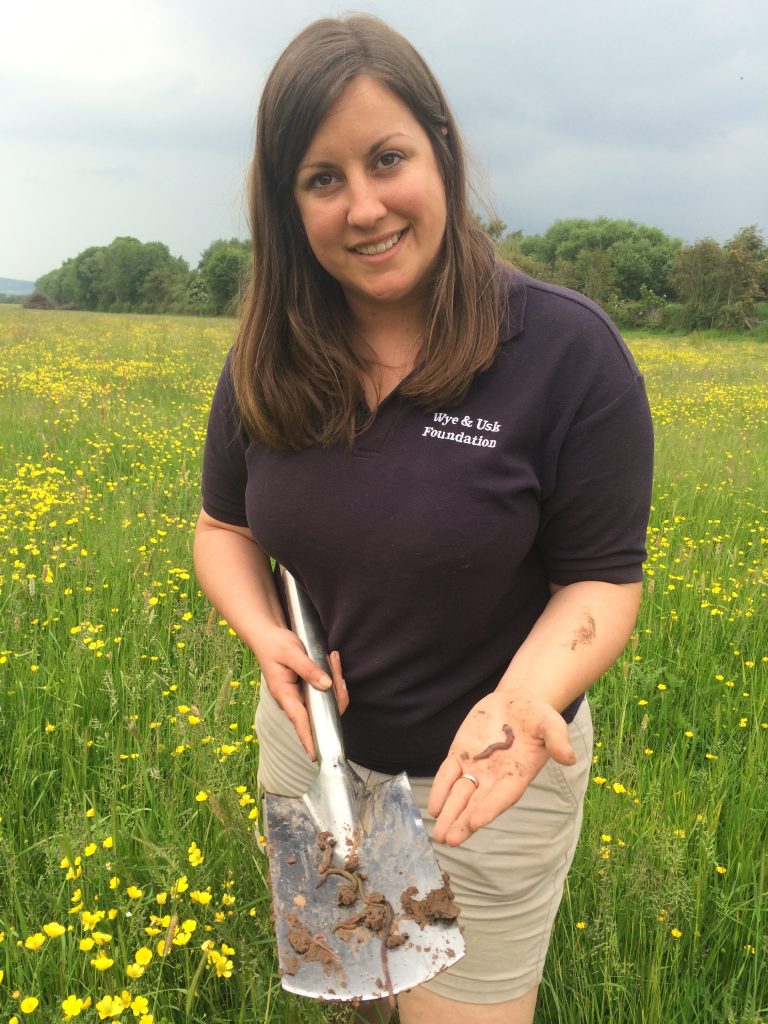
What’s missing? One of the essential ingredients from my Nuffield learnings that is still lacking is regulation. Our Governments have little appetite to deliver on their promises and therefore their agencies have no capacity to do so either. Our Ministers and their teams in DEFRA are delusional to think that generic nationwide legislation like Farming Rules for Water could secure the necessary improvements for specific issues like those faced in the River Wye, especially when they instruct their agencies not to enforce and allow farming unions to lobby the life out of them. As a result, we are left with yet more ineffective legislation and the need for more and more layers to be added on top of all those that have gone before in the hope that one may finally do what should have been achieved long ago.
Any conclusions? The river is in a poor state. Portions of blame can be placed far and wide; water company, local authorities, farmers, processors, retailers, all of us living in or eating food produced from the catchment. But the greatest share of blame falls squarely at our Governments door. There is much good will amongst farmers, retailers and processors to deliver the necessary change and if improvements are secured it will likely be despite our Governments not because of them. In the meantime we continue to persevere, idealistic or not I believe a balance is achievable where food can be produced within the limits and to the betterment of the local environment.
Kate Speke-Adams, Head of Land Use, Wye & Usk Foundation. @HfdshireKate



-
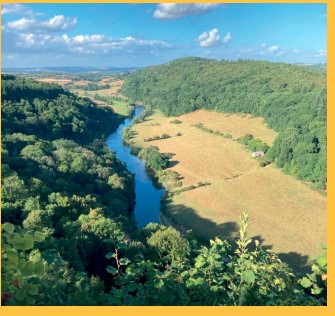
Wye Oh Wye…?
The River Wye intertwines the border of England and-Wales. Once the nations “favourite” river it now probably has more designations than actual fish and continues to regularly feature in the media as the poster girl for agricultural pollution. In this article I hope to provide some insights in the complexities behind the headlines.
WHY THE WYE?
It is designated as a Special Area of Conservation (SAC) and a Site of Special Scientific Interest (SSSI), it contains an Area of Outstanding National Beauty (AONB), Nitrate Vulnerable Zones (NVZ) and Drinking Water Safeguarding Zones (DWSQZ) yet none of these protections have prevented its deterioration. SAC rivers have to meet tighter water quality targets to, in theory, protect their sensitive and rare ecology. So the Wye along with about fourteen other SAC rivers in the UK are trying to metaphorically tighten their belts much more than others.

Is it as green as they say? Algal blooms are caused by a combination of factors, including periods of warm sunny weather and low flows. However when these conditions are combined with a source of nutrients, and in particular phosphorus which acts the same in water as it does in soil, it fuels algae growth. Algal blooms have occurred for decades in the lower reaches of the Wye and are generally attributed to soil and nutrient losses as a result of decades of reasonably intensive agricultural production in Herefordshire, we’re an innovative and industrious lot. However algal blooms are now also occurring in minor tributaries way up in the catchment, which indicates that the pattern of nutrient loss is changing and becoming more widespread.
Thick algal blooms can have severe effects on the river’s ecology. By discolouring the water, essential sunlight is prevented from reaching plants like our precious river crowfoot (ranunculus). Plants play a vital role in the river’s ecology, providing food and habitat for a range of invertebrate, fish and bird species.
SO WHERE IS IT ALL COMING FROM?
The predominant cause of pollution historically in the Wye was due to the poor quality of sewage treatment, however investment over the decades has improved this significantly and source apportionment indicates that Welsh Water are now responsible for only 25-30% of the nutrients in the river. On the other hand, agriculture as an industry is responsible for the lions share at 60-65%.
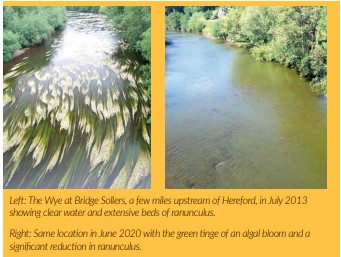
If you stand behind the “its not us Guv” rhetoric of the farming unions, or simply have no faith in our Government and their statutory bodies to undertake their roles effectively (more on that later!), you may question the datasets and dispute these figures. So let me assure you that the same if worse conclusion was also reached by a team of independent researchers at Lancaster University. After a three year study called “REPHOKUS” the Lancaster team have provided significant insight in to the root cause of the Wye’s green waters, detailing how the phosphorus (P) burden in the catchment accumulates and how losses are compounded by our circumstances. Their conclusion was that agriculture accounted for 70% of the P load and that we were accumulating an excess of approximately 3000t of P every year in the Wye.
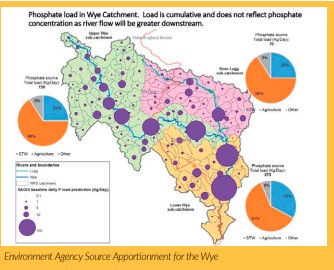
WHY ALL THE CHAT ABOUT CHICKENS?
The REPHOKUS project identified the largest import of P into the catchment as livestock feed (ca. 5000 t P/ yr), nearly 80% of this is attributed to poultry sector, then 18% to cattle and sheep, and 2% to pigs. Fertiliser P imports to the catchment are just over 1000 t yr. From Sun Valley in the 1960s, to Cargill and subsequently Avara, Herefordshire has long been a major producer of broiler chicken. And with the move from cages, a significant number of free range sites have been established to keep up with consumer demand. We are indeed, for want of a better word, a hotspot. The figures thrown around are 20million birds, but no one yet has been able or willing to calculate the exact number. The fact that its chickens we have a lot of is neither here nor there; a lot of anything isn’t good for you.
I alluded to compounding circumstances earlier; the Wye soils are predominantly sandy and silty so are less able to hold on to nutrients, they are “leaky”. And despite what I was taught, P can be lost in solution like N. Once the soils capacity to hold nutrients is exceeded, which for much of the Wye soils appears to be anything above a P Index of 2, it can be lost in soil pore water and starts coming out in the drains. And having an excess of 3000t P every year for quite some time means that we have been building our P indices fairly rapidly.
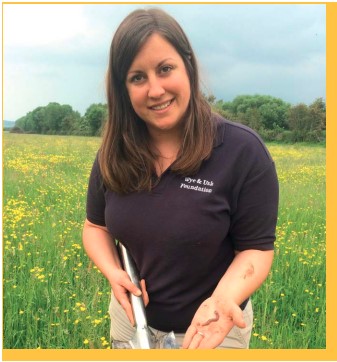
And there you have it, the perfect storm; an ecologically sensitive river, leaky soils and an intensively farmed catchment with a huge excess of Phosphorus.
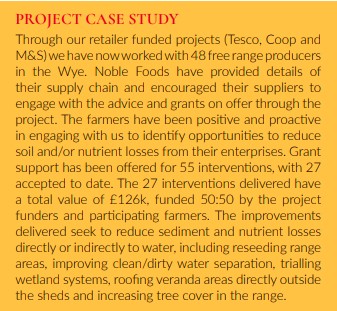
WHO THE HECK AM I ANYWAY?
I grew up in Herefordshire, in the nutrient rich fields of my family’s dairy farm for the sake of transparency, a love for rivers sparked way back in school Geography lessons which led me to spend my working life to date trying to improve their condition. (Early retirement looking less and less likely!) Desperate to learn about how other countries had used finances, education and regulation to address issues with soil and water I applied for a Nuffield Farming Scholarship in 2015. My studies allowed me to see regulatory approaches, funding models, voluntary and educational programmes around the world. I rapidly came to the conclusion that no single mechanism, if implemented alone, could achieve the long-term positive change we needed. There is a sweet spot somewhere in the middle and in the 7 years since my scholarship we still haven’t managed to secure it in the Wye…
What’s actually being done? With my team of advisers at The Wye & Usk Foundation, a charitable rivers trust, we provide support to about 300 farm businesses a year. This work includes the submission of more than £20m worth of Countryside Stewardship Schemes in the last 4 years to help deliver the recommendations we make. In a normal year we hold about dozen on-farm events with local partners, plus provide facilitation for three farmer groups. These enable peer to peer learning, farmers learn best from farmers, those who have changed practices are best placed to explain what motivated them, how they overcame barriers, provide insight to their methods and moral support for others following suit. Much effort has been put in to work more collaboratively between partners operating in the same space. The Farm Herefordshire partnership brings together NGOs like ourselves and Herefordshire Meadows with local delivery staff for the AHDB, Catchment Sensitive Farming and CLA to name but a few, to share resources and deliver more effectively together.
Through our Wye Agri Food Partnership, part of the wider Courtauld Commitment instigated by WRAP, we are delivering collaborative projects with key businesses sourcing or producing food in the Wye. With the support of the Rivers Trust and WWF our work in the Wye currently involves projects with Tesco, Coop, M&S, Muller, Avara, Noble Foods, Stonegate, Kepak and most of the major soft fruit growers. We are working proactively with these businesses to reduce pollution risk at all levels of their supply chains, see our Project Case Study as an example. Several businesses are also independently exploring new technologies to enable the export of excess P from the catchment. If these are successful they could take our P load back in to balance, and ideally in to deficit so that we can start to run down the P backlog…
To do that we need a funding framework that facilitates farming within the limits of our environment. I hoped DEFRA would agree with this ambition and submitted an application to Landscape Recovery Scheme but it was unsuccessful. We now need to find alternative routes to deliver solutions. Along with a significant number of like minded farmers, my vision is to develop long term funding streams that would support us in delivering two key actions: 1. Running down existing high P levels by farming at low or no P input on soils at high risk of losses, and 2. Construction of wetlands downstream of high P fields to buffer the nutrient losses in the meantime.
WHAT’S MISSING?
One of the essential ingredients from my Nuffield learnings that is still lacking is regulation. Our Governments have little appetite to deliver on their promises and therefore their agencies have no capacity to do so either. Our Ministers and their teams in DEFRA are delusional to think that generic nationwide legislation like Farming Rules for Water could secure the necessary improvements for specific issues like those faced in the River Wye, especially when they instruct their agencies not to enforce and allow farming unions to lobby the life out of them. As a result, we are left with yet more ineffective legislation and the need for more and more layers to be added on top of all those that have gone before in the hope that one may finally do what should have been achieved long ago.
Any conclusions? The river is in a poor state. Portions of blame can be placed far and wide; water company, local authorities, farmers, processors, retailers, all of us living in or eating food produced from the catchment. But the greatest share of blame falls squarely at our Governments door. There is much good will amongst farmers, retailers and processors to deliver the necessary change and if improvements are secured it will likely be despite our Governments not because of them. In the meantime we continue to persevere, idealistic or not I believe a balance is achievable where food can be produced within the limits and to the betterment of the local environment.
Kate Speke-Adams, Head of Land Use, Wye & Usk Foundation.
@HfdshireKate
-

Farm Walk – Farm Walk With 2022 Soil Farmer Of The Year Runner-up Andrew Rees

In the first week of August a range of farmers and industry professionals met at Moor Farm in south west Wales to
hear the 2022 Runner-up to the Soil Farmer of the Year competition, Andrew Rees, explain how he has developed a
dairy system with soil health at the centre.Moor farm is a 160 hectare grassland farm near Haverfordwest, which over the previous five years has been undergoing a holistic regeneration away from winter brassicas and a high input system to a fully rotational grazing system integrating diverse species-rich swards. Andrew has seen significant benefits to his business from this change of approach, including a reduction in fertiliser cost and usage alongside better herd health demonstrated by the vast reduction in veterinary fees.
Experimenting with different mixtures and management has led Andrew to create a system intended to provide year-round forage for his dairy herd. Moving away from pure perennial ryegrass leys has had its challenges, but Andrew explains
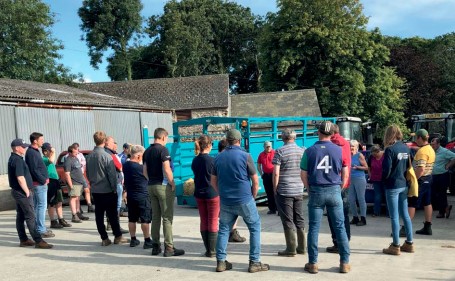
“Working to a 21 day grazing rotation is stressful, you can quickly run out of grass during adverse conditions, the aim of using herbal and diverse leys was to increase the resilience of the grazing platform. Now we have much more ahead of us and much more flexibility within the system where we aim for a 60 day rest period, but this can be up to 120 days in some cases”.
He adds, “We started by sowing simple herbal ley mixtures, but as they were still managed like ryegrass we lost a lot of the diversity and therefore also potential yield. Now we have much longer rest periods between cutting or grazing to allow for regrowth and the leys are far more resilient.” Fields are divided into 0.1 hectare blocks and animals are moved according to need. Andrew now has a keen eye for how much forage his grazing groups require despite the wide diversity of covers across the farm. When asked about his system Andrew states,
“We use a leader-follower approach whereby the R2 cattle (10-22 months old) follow the R1 heifers (3-10 months old), with 24 hours between the groups in each grazing cell. Having the smaller cattle grazing first means they have preferential grazing and we are not limiting their intake in any way, not forcing young animals to graze down also helps lower worm burdens. Older animals can then be pushed a bit harder and are able to deal with the more mature forage”
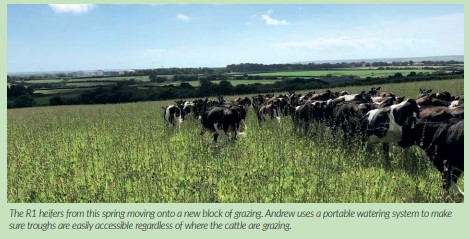
He further adds, “Anything which isn’t grazed is hopefully trampled; that is when we know we have the stocking density and number of moves per day right – if the ley is starting to become a bit stemmy we move them more often, up to three times per day.”
This trampling action which Andrew integrates into his system has wider benefits for the soil in that it is better protected from environmental conditions and also now of higher quality with the constant organic additions from the leys above. Andrew fully promotes this system outlining to the group,
“Changing grassland management has given conditions for native seeds to germinate. We don’t want bare soils that cap and produce the conditions for weeds to appear. By keeping the surface covered with either growing plant matter or the trampled residue, we reduce our weed burden.”
Since the transition to more speciesrich leys Andrew has found, “The different rooting systems we have in the fields open the soil up and improve the structure, therefore we are removing the conditions in which weeds can become dominant.”
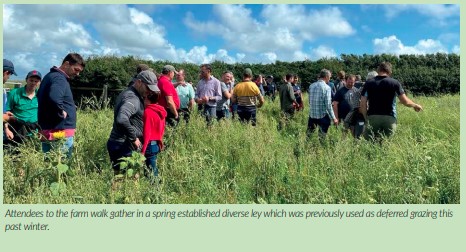
The system Andrew has created focusses on a long rotational grazing platform for both the milking herd and young stock combined with deferred grazing to provide areas for outwintering cattle. He explains,
“We used to have kale in the rotation to provide over-winter feed but were finding that there was far too much damage and soil wash. We now use a deferred grazing system to out-winter our R1 heifers which are between 8 to 10 months old. We position bales when the land is dry and travels well, ready to provide additional feed throughout the winter period.” The condition of the soil and the health of the livestock are the key priorities when outwintering stock, to manage this Andrew explains, “Heifers that are outwintered are scheduled to move every two days, but this can increase to three times daily to avoid soil damage if conditions become wet. This system works for us as our heifers are light and we still have the capacity to bring them in-house if the weather or soil requires it.”
Following these outwintering processes, fields are re-seeded, with Andrew tailoring off-the-shelf mixtures to suit his system, “We have started reseeding with a half-rate Cotswold herbal ley mix, with half-rate Barenburg Barrmix (this was more because it’s what I had in the shed to give right balance of clovers and herbs) with additional annuals to provide a boost to performance in the first year whilst the other species establish”.
When establishing his leys, Andrew aims to use as simple and minimal cultivation system as possible, removing old or tired leys with low rate glyphosate buffered with humic and citric acid to lower the pH. He then drills the seed in two directions to increase the eventual cover with an application of seaweed to give a starter boost of nutrition.
Andrew has, on average, reduced nitrogen usage by 140kg per hectare whilst still producing silage for the milking herd. He has recently started silaging the herbal leys which are highly diverse and contain species such as pea, barley, vetch, sunflowers, linseed, radish, chicory, plantain and a mixture of clovers. This will be analysed when the clamp is reopened and fed as part of the usual ration. In addition to regularly analysing silage, Andrew also frequently tissue tests his leys – results suggest the mineral content of his leys are double that found when they were in a perennial rye grass system. The species composition has a naturally far lower demand for nitrogen compared to perennial ryegrass and is much better at scavenging existing nutrients within the soil, further reducing the need for artificial inputs.
Andrew uses slurry in combination with a Tow and Fert system to help maintain fertility and production across the farm. Fields destined for silage are given slurry before and after the 1st cut with a 25kg sprinkle of N prior to cutting. The Tow and Fert is used to top up fine lime, phosphate and humates alongside some foliar potassium. Andrew samples a fifth of the farm every year, with the whole farm last sampled in 2018 – having this up to date data allows him to understand where his nutrients are most required and move away from broadacre applications. Fine lime is regularly used across the farm with Andrew detailing, “Applying fine lime helps increase the free exchangeable calcium in the system, we are aiming to have calcium at luxury levels which will take time but will help with the longevity and palatability of the tall covers.”
As a dairy farmer, herd health is a main priority for Andrew. Through implementing changes to grazing species composition and management, alongside reducing the nitrogen use across the farm, livestock performance has seen vast improvements. The dairy herd are also grazed on diverse summer cover crops, being turned out for a few hours after milking.
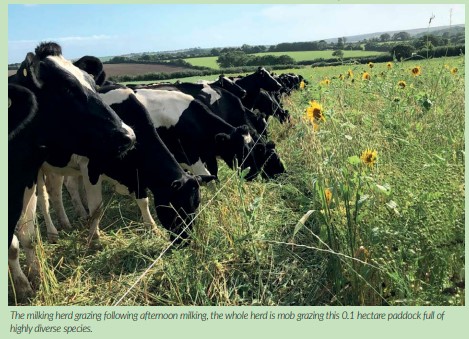
Andrew explains this strategy, “Having the cows grazing across the diverse leys has improved butter fats and allowed us to stretch out the grazing season where historically we may have run out of grass. This means that the herd is currently balanced between herbal leys, traditional grass pasture and silage in the yard when they come in to be milked. The additional grass means we only need to supplement feed them around 4kg of cake per day, massively reducing costs.”
The cows are now found to be far more content, with lower nitrogen covers thought to lower the free nitrates in their system, reflected in the results of the milk testing. This contentment has also improved fertility and the health of the dairy herd. Empty rates have decreased from 10.5% in 2019 to 5.5% in 2021 with mastitis per 100 cows also reducing from 19.7 in 2019 to 3.5 in 2021.
The increased fertility in the herd has also allowed Andrew to move his spring calving system later so they can calve to match the grass growth, reducing the housing requirement as calves are weaned on grass with outside grazing access from 4 weeks of age. Worm burden has also drastically reduced and consequently, so has the requirement for anthelmintic products. Faecal egg counts are conducted to see if any wormers are required, however Andrew has found that due to the long-grass grazing system with animals biting higher up the plant in combination with chicory rich pastures, very little, if any, are required.
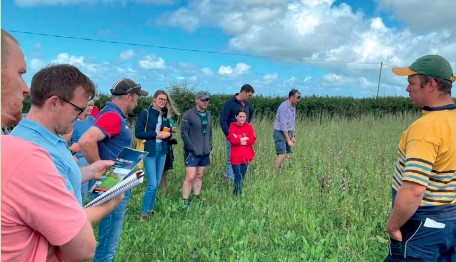
When asked about how he would advise others beginning along the herbal or diverse ley journey Andrew has these words of wisdom, “Start by drilling the leys in the spring as this gives a much better chance for establishment whilst you are experimenting with your system. If you are going in later when the conditions could be dryer or colder it might be tough on the clover to get up and away.” At Moor Farm, the leys are highly diverse and full of many different species. Andrew’s thinking behind this is, “When you establish herbal leys you can often see a drop in yield compared to a perennial ryegrass whilst they establish, therefore we also drill in summer annual species to help build the quantity of forage available to graze. If we are establishing a ley in the spring, we would expect to be able to graze it that autumn. However, this would be a lighter graze than in the second year and not as tight, just to make sure we don’t stress the plants too much”.
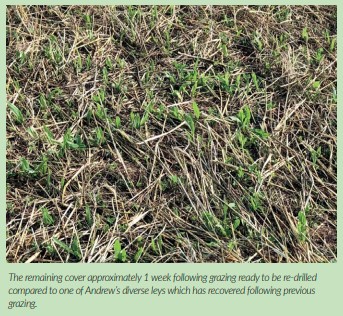
The next challenges for Andrew focus further around nitrogen reduction, as he discussed with the group, “The aim would be to be using zero chemical nitrogen whilst managing to maintain our current production. I want to be able to leave the land in a better condition than when we started whilst also being financially profitable.”
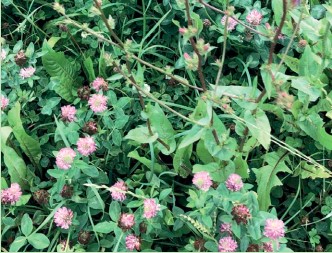
During the Soil Farmer of the Year competition, the judges found Andrew’s approach highly innovative, understanding how to maximise the health of the soil to produce high quality, mineral rich forage for his cattle using less inputs, but instead through his grazing and nutrient management system. The benefits Andrew has observed upon the health, welfare and productivity of his cattle through diversifying the leys has been highly successful – also giving him additional flexibility in other areas of the farming business now he is secure in the growth of forage on the farm, developed through increasing the resilience of his system.
-
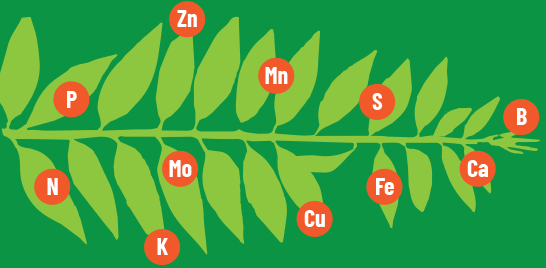
How to interpret sap analysis
In the third part of our series on sap analysis, Mike Abram learns how to interpret the results.
You’ve taken your leaf sample, packaged it up and sent it to the Netherlands, and now the results have landed in your inbox. There’s a whole ray of bars and numbers for just about every nutrient you could possibly wish to measure. But where do you start when trying to interpret the results, what does it all mean, and how can you use the information to make better decisions?
NovaCropControl’s analysis is split into four sections – at the top are the sugar, EC (total dissolved salts) and pH levels of the sap, followed by the cation nutrients, the anions and at the bottom the trace elements.
For each nutrient the report shows what the current level is for young leaves in a light green bar, and older leaves in dark green. There are target values for each nutrient, which are calculated from analysis of at least 500 samples from different fields and growers. The bars are split into three sub-sections representing levels that are too low, good, and too high in the sap.
Broadly there are four stages to interpreting the results, suggests Eric Hegger, a consultant with NovaCropControl.
“Always start with which elements are high, which are low – are there any in excess or deficient. The next thing is the difference in uptake between young and old leaves, looking at nutrient mobility.”
As explained in more detail in Direct Driller, July 2022, it’s important to understand which elements are mobile in the plant, and which are immobile to recognise which leaves are more critical to be looking at.
“Then look at the interactions within the cations and / or anions, and if you still don’t have an answer to why any of the elements are too high or too low in uptake, look at what environmental factors might have influenced mineral uptake – for example, climate, pH, soil life, etc.
“In the end that should give most of the answers to know what corrections might need to be made,” he says.
So what might it mean if an element is in excess or deficient in an analysis you receive? Let’s use examples of a barley crop from Australia and Ireland (see charts) to help explain the importance of each different variable analysed.
Total sugars: Often this will be linked to level of nitrate in the plant, with high sugars meaning low nitrate and vice versa. “If the plant takes up a lot of nitrate it has to convert it to protein to use for growth. But if the plant takes more nitrate up than it can use for growth it starts to build up, and you measure that in the sap as higher nitrate levels.”
High nitrate in the plant means a lot of vegetative growth, which in turn means a lot of water in the plant which dilutes the level of sugars,” explains Mr Hegger.
“High levels of sugar in the plant could be an indication of good crop health, as we know that means lower nitrate levels and the moment nitrate gets too high the plant is more attractive to pests and diseases.”
Another possible reason for low sugars is there is not enough photosynthesis for sugar production and active growth.
Typically, growers should be looking for total sugar to be relatively high, especially in younger leaves, although too high levels can be caused when there’s not enough water movement – for example, very hot weather causing plant stomata to close drying the plant out and causing the sugars to concentrate.
pH: In plant sap analysis, pH is not usually that informative, Mr Hegger suggests. “It is nothing to do with pH of the soil, usually doesn’t vary much from sample to sample, so in most cases I don’t look at this much.”
EC: In contrast, EC, which is a measure of the total dissolved salts in the plant, is very important to look at as it gives a measure of whether there is enough nutrition uptake, or the transport of nutrition into the new leaves.
“For example, if the new leaves are very low and the old leaves very high that could indicate the weather has been extreme and the plant has stopped evaporating and couldn’t transport enough nutrition to the new leaves,” Mr Hegger explains.
“But in most cases the EC shows if there is enough nutrition uptake.”
Cations (Potassium, Calcium, Magnesium): In the previous article, the antagonistic behaviour of the cationic nutrients was discussed – if one is too high, uptake of the others can be blocked.
In the example below (chart 1) that’s clearly the case with potassium in excess, while calcium, magnesium and sodium to a lesser extent deficient, Mr Hegger says.
“It’s possible there is enough calcium and magnesium available in the soil but the plant cannot take it up because of the high potassium, so the grower has to do something about his potassium input. Mostly it comes from manure or compost, and maybe the input is too high.
“Eventually that could influence crop health and quality.”
Potassium deficiencies usually start in old leaves as it is a mobile element, and the young leaves will take potassium from the old leaves. For calcium it is important to look at the result for the young leaves because it is an immobile element and deficiencies will show there first.
There are no target levels for the potassium to calcium ratio as even if the ratio is correct both could be too low or too high. It’s less important for grain crops, but in fruit crops, such as tomatoes, it’s critical for fruit quality.
As with the other cations, if magnesium is too high it can often block uptake of potassium and calcium.
It is quite common the cations are not optimally balanced in sap analysis and treating the excess rather than the deficiency is likely to have better results. However, in the field it can be relatively difficult to manipulate these elements very quickly, Mr Hegger admits.
“Before you plant the crop, when you use base fertiliser or apply compost or manures, you set the base for the entire season. During the season it’s not possible to do big corrections on the soil. You can do a foliar spray to try to make a correction if something is really too low, but don’t expect you’re going to make big changes in the crop.”
In the first year of analysis, often it is trying to learn from the results and understand how longer-term management, particularly of soil nutrients, can help, he says. “It can take more than a year to make a correction in the soil, before you see a reaction in the plant.”
Environmental conditions can also play a part. For example, high temperatures and light intensity can block calcium uptake. “It’s why it is important to take samples every two to three weeks to see how levels change in the crop. If it is weather that is blocking the calcium and three weeks later the weather is normal, the levels might be back to the target levels.”
Sodium doesn’t have to be in the target values for grain crops, although it is important for some crops. “If it goes above the target values, then it can block the uptake of the other cations.”
There are four measurements related to nitrogen: ammonium, nitrate, nitrogen in nitrate and total nitrogen. Ammonium levels can be affected by the time the sample is in transport, says Mr Hegger. “If it is high that’s something to consider, otherwise it is an indicator of stress in the plant.”
In barley and wheat, nitrate is almost directly converted to proteins, so if it is too high it is an indication that too much has been supplied, Mr Hegger suggests. “Generally, it is important to get your nitrate levels as low as possible, as long as your total nitrogen levels are high enough.
“In barley and wheat total nitrogen is more important as this gives an indication of crop growth. If it too high, the plant will be more sensitive to pests and diseases.
“As long as total nitrogen is not getting below the target values, you know it is good enough, and fortunately nitrogen is easier to correct.”
N in nitrate is a measure of the health of the plant. A high proportion of N in nitrate compared with total nitrogen is an indicator of lower plant health in some crops, such as tomatoes. “Unfortunately we can’t use that trick in cereals because of the low nitrate levels in the crop, so it doesn’t mean so much.”
Chloride, like sodium, is not particularlyimportant as long as it is not too high. If it is higher than the target value it can block uptake of other anions.
Sulphur is an important element for many processes in the plant. Like calcium it is relatively immobile so look at the young leaves for signs of deficiency.
Ideally, phosphorus levels shouldn’t be too high, so aim for these to be within the target values. “If it is too high, inputs can be reduced as it will block iron, manganese, or zinc uptake.”
Aim for silica to be within the target values, as it helps with uptake of calcium and the health of the plant. “You can try to correct with a foliar spray, but it is not easy depending on crop.”
Iron deficiency will show first in younger leaves, but it doesn’t matter too much if the old leaves are too high, while manganese can easily get too low. “For the plant it is like a sweet – it’s the easiest for it to take-up, but also one of the easiest to leach out of the soil.”
Trace elements, which also includes zinc, boron, copper and molybdenum are easier to treat with foliar sprays.
No target levels are given for aluminium as ideally, for most crops, you don’t want any showing up, Mr Hegger says.
Sap analysis interpretation
- Start with excesses and deficiencies
- Look at differences in uptake between young and old leaves
- Consider interactions between cation elements, and between anions
- Are there environmental factors influencing results
- Treating cations excesses may help more than treating deficiencies
- Cations are less receptive to in-season corrections
- In cereals, total nitrogen is important – too much means poor health, not enough will give poor growth
- Trace elements easier to treat with foliar applications
Example sap analysis in barley from Australia

What the Australian analysis shows?
The low sugars, calcium and boron levels are an indication of the crop likely being under climate stress and not growing well, suggests Mr Hegger, while the high ammonium is almost certainly due to the length of time the sample has been transit.
Another sample should be taken in three weeks to see what changes in climate cause to the crop and sap.
High potassium levels are likely to be blocking calcium and magnesium uptake so, while foliar applications of those could be tried, a more long-term solution is adjusting potash inputs on the field and attempting to raise magnesium and calcium in the soil perhaps.
Total nitrogen is on the high side so lower inputs could be considered.
Boron and manganese deficiencies could be treated with foliar sprays.
Example sap analysis in barley from Ireland

What the Irish analysis shows?
Sugar levels are good in this crop, which shows it is growing well. Calcium and magnesium levels are high, but potassium is within the target values so no immediate issue. However, could the grower do something to reduce calcium and magnesium levels for the nest season to avoid risk of blocking uptake of potassium?
High nitrate levels suggest supply might be high, although total nitrogen is within target values. This suggests the crop has taken up a lot of nitrate but cannot convert directly to proteins – potentially an indicator of disease or pest problems in the crop, as there isn’t a lack of other nutrition in the form of magnesium, sulphur, manganese and molybdenum preventing conversion of nitrogen to protein.
A follow up sample to confirm low phosphorus would be beneficial, while high manganese is probably blocking iron uptake.




-

How To Interpret SAP Analysis
In the third part of our series on sap analysis, Mike Abram learns how to interpret the results
You’ve taken your leaf sample, packaged it up and sent it to the Netherlands, and now the results have landed in your inbox. There’s a whole ray of bars and numbers for just about every nutrient you could possibly wish to measure. But where do you start when trying to interpret the results, what does it all mean, and how can you use the information to make better decisions? NovaCropControl’s analysis is split into four sections – at the top are the sugar, EC (total dissolved salts) and pH levels of the sap, followed by the cation nutrients, the anions and at the bottom the trace elements.

For each nutrient the report shows what the current level is for young leaves in a light green bar, and older leaves in dark green. There are target values for each nutrient, which are calculated from analysis of at least 500 samples from different fields and growers. The bars are split into three sub-sections representing levels that are too low, good, and too high in the sap. Broadly there are four stages to interpreting the results, suggests Eric Hegger, a consultant with NovaCropControl.
“Always start with which elements are high, which are low – are there any in excess or deficient. The next thing is the difference in uptake between young and old leaves, looking at nutrient mobility.” As explained in more detail in Direct Driller, July 2022, it’s important to understand which elements are mobile in the plant, and which are immobile to recognise which leaves are more critical to be looking at. “Then look at the interactions within the cations and / or anions, and if you still don’t have an answer to why any of the elements are too high or too low in uptake, look at what environmental factors might have influenced mineral uptake – for example, climate, pH, soil life, etc.
“In the end that should give most of the answers to know what corrections might need to be made,” he says. So what might it mean if an element is in excess or deficient in an analysis you receive? Let’s use examples of a barley crop from Australia and Ireland (see charts) to help explain the importance of each different variable analysed. Total sugars: Often this will be linked to level of nitrate in the plant, with high sugars meaning low nitrate and vice versa. “If the plant takes up a lot of nitrate it has to convert it to protein to use for growth. But if the plant takes more nitrate up than it can use for growth it starts to build up, and you measure that in the sap as higher nitrate levels.”
High nitrate in the plant means a lot of vegetative growth, which in turn means a lot of water in the plant which dilutes the level of sugars,” explains Mr Hegger.
“High levels of sugar in the plant could be an indication of good crop health, as we know that means lower nitrate levels and the moment nitrate gets too high the plant is more attractive to pests and diseases.” Another possible reason for low sugars is there is not enough photosynthesis for sugar production and active growth. Typically, growers should be looking for total sugar to be relatively high, especially in younger leaves, although too high levels can be caused when there’s not enough water movement – for example, very hot weather causing plant stomata to close drying the plant out and causing the sugars to concentrate. pH: In plant sap analysis, pH is not usually that informative, Mr Hegger suggests. “It is nothing to do with pH of the soil, usually doesn’t vary much from sample to sample, so in most cases I don’t look at this much.”
EC: In contrast, EC, which is a measure of the total dissolved salts in the plant, is very important to look at as it gives a measure of whether there is enough nutrition uptake, or the transport of nutrition into the new leaves. “For example, if the new leaves are very low and the old leaves very high that could indicate the weather has been extreme and the plant has stopped evaporating and couldn’t transport enough nutrition to the new leaves,” Mr Hegger explains. “But in most cases the EC shows if there is enough nutrition uptake.” Cations (Potassium, Calcium, Magnesium): In the previous article, the antagonistic behaviour of the cationic nutrients was discussed – if one is too high, uptake of the others can be blocked.
In the example (chart 1, left) that’s clearly the case with potassium in excess, while calcium, magnesium and sodium to a lesser extent deficient, Mr Hegger says.
“It’s possible there is enough calcium and magnesium available in the soil but the plant cannot take it up because of the high potassium, so the grower has to do something about his potassium input. Mostly it comes from manure or compost, and maybe the input is too high.
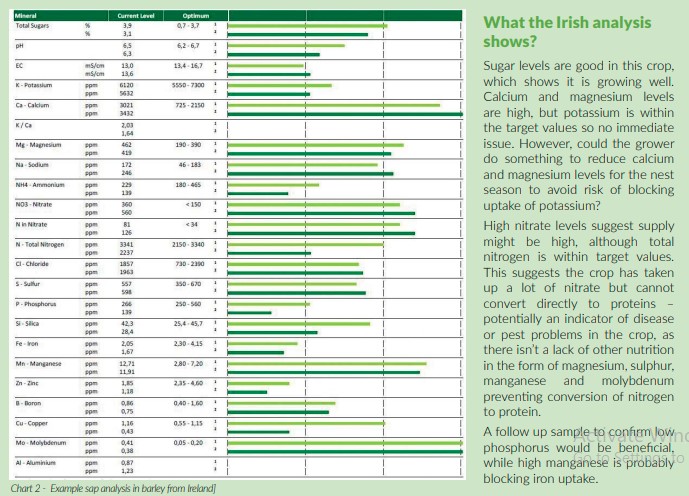
“Eventually that could influence crop health and quality.”
Potassium deficiencies usually start in old leaves as it is a mobile element, and the young leaves will take potassium from the old leaves. For calcium it is important to look at the result for the young leaves because it is an immobile element and deficiencies will show there first. There are no target levels for the potassium to calcium ratio as even if the ratio is correct both could be too low or too high. It’s less important for grain crops, but in fruit crops, such as tomatoes, it’s critical for fruit quality. As with the other cations, if magnesium is too high it can often block uptake of potassium and calcium. It is quite common the cations are not optimally balanced in sap analysis and treating the excess rather than the deficiency is likely to have better results. However, in the field it can be relatively difficult to manipulate these elements very quickly, Mr Hegger admits.
“Before you plant the crop, when you use base fertiliser or apply compost or manures, you set the base for the entire season. During the season it’s not possible to do big corrections on the soil. You can do a foliar spray to try to make a correction if something is really too low, but don’t expect you’re going to make big changes in the crop.”
In the first year of analysis, often it is trying to learn from the results and understand how longer-term management, particularly of soil nutrients, can help, he says. “It can take more than a year to make a correction in the soil, before you see a reaction in the plant.”
Environmental conditions can also play a part. For example, high temperatures and light intensity can block calcium uptake. “It’s why it is important to take samples every two to three weeks to see how levels change in the crop. If it is weather that is blocking the calcium and three weeks later the weather is normal, the levels might be back to the target levels.”
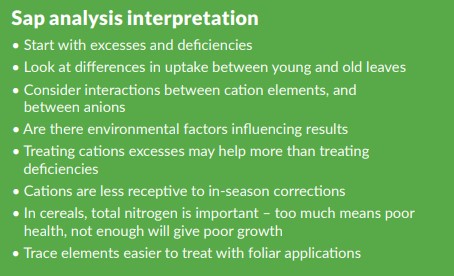
Sodium doesn’t have to be in the target values for grain crops, although it is important for some crops. “If it goes above the target values, then it can block the uptake of the other cations.” There are four measurements related to nitrogen: ammonium, nitrate, nitrogen in nitrate and total nitrogen. Ammonium levels can be affected by the time the sample is in transport, says Mr Hegger. “If it is high that’s something to consider, otherwise it is an indicator of stress in the plant.” In barley and wheat, nitrate is almost directly converted to proteins, so if it is too high it is an indication that too much has been supplied, Mr Hegger suggests. “Generally, it is important to get your nitrate levels as low as possible, as long as your total nitrogen levels are high enough.
“In barley and wheat total nitrogen is more important as this gives an indication of crop growth. If it too high, the plant will be more sensitive to pests and diseases.
“As long as total nitrogen is not getting below the target values, you know it is good enough, and fortunately nitrogen is easier to correct.”
N in nitrate is a measure of the health of the plant. A high proportion of N in nitrate compared with total nitrogen is an indicator of lower plant health in some crops, such as tomatoes. “Unfortunately we can’t use that trick in cereals because of the low nitrate levels in the crop, so it doesn’t mean so much.” Chloride, like sodium, is not particularly important as long as it is not too high. If it is higher than the target value it can block uptake of other anions. Sulphur is an important element for many processes in the plant. Like calcium it is relatively immobile so look at the young leaves for signs of deficiency.
Ideally, phosphorus levels shouldn’t be too high, so aim for these to be within the target values. “If it is too high, inputs can be reduced as it will block iron, manganese, or zinc uptake.” Aim for silica to be within the target values, as it helps with uptake of calcium and the health of the plant. “You can try to correct with a foliar spray, but it is not easy depending on crop.” Iron deficiency will show first in younger leaves, but it doesn’t matter too much if the old leaves are too high, while manganese can easily get too low. “For the plant it is like a sweet – it’s the easiest for it to take-up, but also one of the easiest to leach out of the soil.”
Trace elements, which also includes zinc, boron, copper and molybdenum are easier to treat with foliar sprays. No target levels are given for aluminium as ideally, for most crops, you don’t want any showing up, Mr Hegger says.
-

Farmer Focus – Philip Bradshaw

I ended my previous article noting the challenges ahead, but with some optimism for the season, and the forthcoming harvest. However, I had underestimated how exciting it was to get, and how much volatility we would come to enjoy!
Our crops continued to look well through the spring and early summer. The spring beans established nicely and grew quickly. Sometimes with all crops, it was a challenge to keep on top of treatment timings, especially when I spent some time away on off farm work. I managed to buy a lot of our inputs at the right time, but unfortunately, I had to buy some of our Nitrogen fertiliser at the higher prices. I offset this with some appropriate wheat sales, and while I can’t claim to have got everything right, we will have good averages on both input acquisition, and crop sales for harvest 2022.Thankfully, with our system fuel use is very low, and we have been reducing nitrogen use steadily for some years, which has given us the confidence to appropriately use even less for this harvest year.
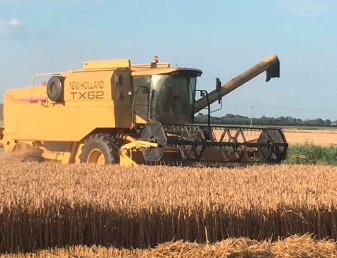
The incredible summer weather we enjoyed did speed crop development, and our annual rogueing season at Whittlesey was a joy, with little in the way of blackgrass to be found. We even found time to have a couple of fantastic days at the Groundswell show, in a hired campervan, and enjoyed seeing lots of interesting speakers, meeting friends old and new, and the evening refreshments! Harvest for us started with the Winter Barley, and it was our best barley ever. The yields varied from 11t/ha on some heavier fields to 9t/ha on lighter land, so we ended up with an average of just 10t/ha over a weighbridge, despite a drought and seasonally reduced inputs.
Sadly though, the OSR which followed was less exciting. We drilled on two occasions last August, with rain forecast within days, that never came. As such, some areas were very thin. I wrote some off before the winter Astrokerb application, and this was re drilled with beans, but with hindsight I should have written a little more off. The average harvested yield was 2.56t/ha, which is half what we used to yield a few years ago, but there was too much thin crop pulling down the average. The price though is decent, and the input costs were low. The wheat was a much better story and was consistently decent across all farms. The farm at Newborough was all KWS Firefly, and this has averaged well over 10t/ha. At Whittlesey we achieved a similar average, but with some variation. The second wheat KWS Zyatt averaged 10t/ha which was pleasing and lifts the farm margin by reducing our area of less profitable break crops, and our first wheat KWS Extase and KWS Firefly averaged 11 t/ha.
With little storage on farm, and the early harvest pressures on the grain trade and central stores we had to wait to clear wheat before we could cut the beans, but the dry weather continued, and they were all done before the Bank Holiday. Sadly, the beans were a little disappointing. Last year we averaged almost 6t/ha across all the beans, and this year we are only just above half that. Those super-hot days that we enjoyed in July effectively killed most of the crop off, and we had very small beans. Overall, though, with most of the farm in wheat and barley, we had a good harvest, with no drying, and good prices so far – a memorable season. As usual, we did some on farm trials. Philip Wright, our friend, and consultant helped with trials on tyre pressure, and soil loosening with the paraplow. The tyre pressure trial was similar to last years, and was interesting, as we drilled in autumn 2021 in drier conditions than 2020. The result was that while there was a little difference between the low and medium pressure area compared to untrafficked land, there was still a more significant yield loss in the high pressure area.
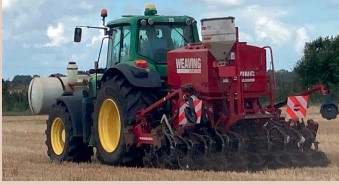
The soil loosening trial gave interesting results. In field analysis through the season showed better biological activity and rooting in the paraplowed area, particularly where we also applied biological amendments, and this showed in yield assessments at harvest. On the paraplowed land there was a tiny gain with the amendment over that without. However, the unmoved land had a substantial yield penalty over the loosened land. Obviously these are not extensive replicated trials, but they do show that when required loosening is appropriate, and I will continue to add biological amendments expecting a cumulative effect over time.
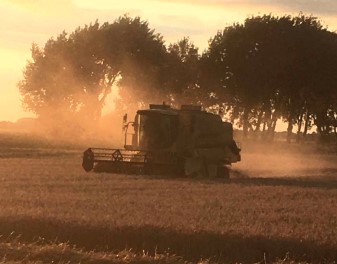
The final trial I did was with a field of KWS Extase. I decided after our N1 application on a whim to do a low input trial, so 2 ha of the 12 ha field had only the first N dose of 46kgN/ha as a liquid, and no more fertiliser, and I also reduced the already modest fungicide and PGR programme on the low input area. Again, this is a basic farm experiment, with little replication, but the results were interesting. The weighbridge calibrated yield monitor on the combine harvester gave an average full header yield of 12.24t/ha low input, against a 12.36t/ha for the control area which had normal treatment including 110kg/ha N as liquid. This surprised me, and may be a quirk of the season, but I will push lower still with N next year, particularly on the skirt fen soils. However, it was clear from the delivery results, that the low input area had lower proteins, and this will need to be considered in a milling wheat situation.
Unfortunately, the clover living mulch crop that we planted ahead of beans has failed. Like the OSR last August, the rain never came. I want to try it again and may try and under sow some in the spring. So, for next year what are our plans? The dry weather and soils post-harvest have ruled out planting OSR or clover here this year due to the risk associated with the dry conditions. I did plant about half of the planned catch/cover crops with a multi species blend. This was done with the GD disc drill rather than the Sabretine to try and preserve the moisture. Keeping living roots in the soil is an important part of the system for us, but in a dry season like this we need to react accordingly.
We are paraplowing the 20% of the farm at Whittlesey that wasn’t done last year, and this will be pressed to reconsolidate. Our home saved wheat seed has tested clean for disease, so it will be cleaned on farm and treated only with Tiros before drilling from mid-October.
Looking ahead we need to refine our system further and reduce artificial inputs when possible. The challenge though is achieving a balance between reducing inputs appropriately, while also maintaining a decent level of crop output to be profitable. The inflation in our costs, including last year’s rent rise, is substantial, and the risks associated with farming now are more significant than ever.
-

Sustainable Food: How Can Ecolabels Help Transform Entire Value Chains?
With sustainability being placed higher and higher on consumers’ agendas, people are turning to high-emitting
industries to ask how they are playing their part in reducing environmental impacts on the planet. The food industry
alone accounts for one third of emissions globally – and with population rising, the challenge of feeding the planet
while lowering our footprint is becoming more real than ever.By Laura Nolan and Cliona Howie, Foundation Earth
An increasing number of brands are making efforts to green their products, be more sustainable and communicate that to their buyers in a credible way. Many green claims are being made left, right and centre – but how do you back up and qualify a food product’s ecofriendliness in an accurate, transparent way? What is being measured exactly, and what information and data can we access to verify such claims? How can we move towards a food system that doesn’t just reward client-facing brands, but also farmers and producers who contribute to making value chains more sustainable?

The role of ecolabels
One example is the use of ecolabels placed on products, that show consumers just how much that item costs the environment in an easy, accessible way (you’ve most likely seen those traffic light systems on your home appliances!). This trend isn’t new: 84% of consumers believe it’s important for each person to contribute to sustainability (Source: Kerry Group, “Sustainability in Motion”), and many companies are starting to respond to the demand for corporate transparency – from fashion, to beauty, electronics and of course, food.
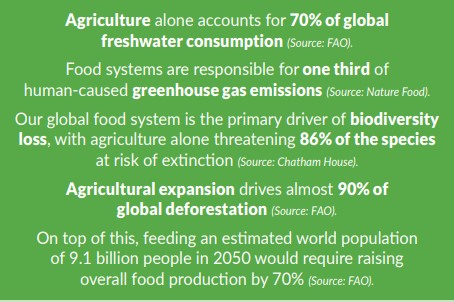
But what do ecolabels show exactly? Well, there are over 500 environmental labels out there: a lot of them focus on carbon footprint (CO2 emissions), some will tell you if a product is organic or not, and others try to look at a broader range of measures like water use, water pollution and biodiversity. Some even include other ethical indicators such as working conditions or animal welfare. The scopes are large and diverse, there is no “one size fits all”, and there isn’t a consistent, harmonised approach.
Regulation is underway – the European Union has worked towards the development of a unified method to communicate environmental information of products across the European Union – the Product Environmental Footprint (PEF) Method – since 2013. PEF, for example, measures 16 different environmental impact categories. The French government has also been building a national environmental scoring system for food products, and similar initiatives are underway in The Netherlands and Denmark.
We need better data!
And yet, current approaches to assess the environmental impacts of individual food products remain limited. Often, proxy data is used to generate an estimate of a product’s impact, and the true impact of a specific product is never known. That means that if an actor in the value chain (for example a farmer) is making active efforts to green its processes, that most likely won’t show up in the final score due to the use of averages.
Impact scores based on secondary data are easier, quicker and cheaper to obtain, but without accurate information on a product-by-product basis, environmental impacts cannot be meaningfully managed and the climate crisis will intensify. And without an accurate. per-product understanding of where the highest environmental impacts are in a supply chain, food producers are not incentivised to grow, manufacture, transport or sell their products more sustainably.
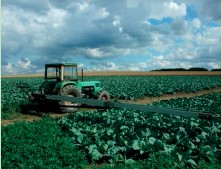
Here’s the thing: ecolabels don’t only help consumers choose a product – when the assessments are done accurately and in-depth, using methods such as Life Cycle Assessments (LCA) for example, they can also help food producers reduce the environmental impacts of their production and produce in a better way. They act as key source of intelligence to help industry players pinpoint where their highest impacts are, and what can be done to improve them. That’s when ecolabels also become a powerful data-driven tool to build more sustainable food systems.
At Foundation Earth, we are working to develop a method that scores food products in the most accurate way possible, based on LCAs using the highest quality data available. We map the supply chain, assess the impacts throughout and tell brands where they might be going wrong. At the same time we are comparing different existing methods to pull out the best of them all and create a single method that will allow brands to have a comprehensive view of their supply chain and know where improvements can be made.
Recognising actors across the supply chain
So, brands are starting to place more and more emphasis on their sustainability efforts – but what does this mean for the other actors along the supply chain? The nice shiny label is sitting on the product pack, but how does that help all food players, from farmers to marketers, to demonstrate their sustainability efforts?
For now, it doesn’t really. Everyone in the chain has contributed to that final score (either negatively or positively!), so why do they miss out on the acknowledgement? At Foundation Earth we believe there is a real gap here, because to transform entire food systems we need to recognise the do-gooders and incentivise others to join in these efforts. If a farmer is doing their best to place sustainability at the heart of their business model, and probably even seeing the direct benefits of their actions on biodiversity around them – for example – this should be celebrated. Because every effort counts.
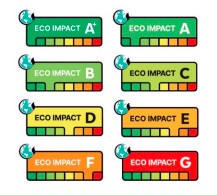
That’s why we are launching new pilots calling all pioneers to be part of Foundation Earth’s trials and pave the way for food system transformation. We are aiming to deliver a standard, scalable product footprinting system not only for brand owners but also producers and retailers, that will connect entire value chains and give recognition where it is due by delivering our label across the chain. This will in turn unlock commercial value for businesses and support all actors in achieving their net-zero goals.
A food ecolabel for all
What will this look like concretely? We already have our scoring system for final products – remember that traffic light system mentioned on your home appliances? Our Foundation Earth Eco Impact labels apply a similar system: our scores range from A+ to G (A+ being green and representing the lowest environmental impact, G being red and representing the highest) and are recertified yearly, making it possible for products to improve their grade. But instead of labels just being on final, packaged products, ingredients and processes could be certified at each step of the value chain as well, bringing recognition to all those businesses applying sustainability principles and helping business-to-business (B2B) buyers find alternative, sustainable options.
Transforming food systems for the better will take active participation from us all. And it’s only by recognising and celebrating efforts that we will build a movement big enough to create actual change and leave way for food systems that won’t harm the planet.
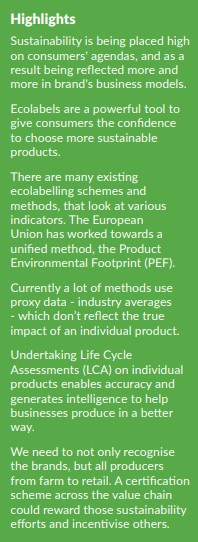
-
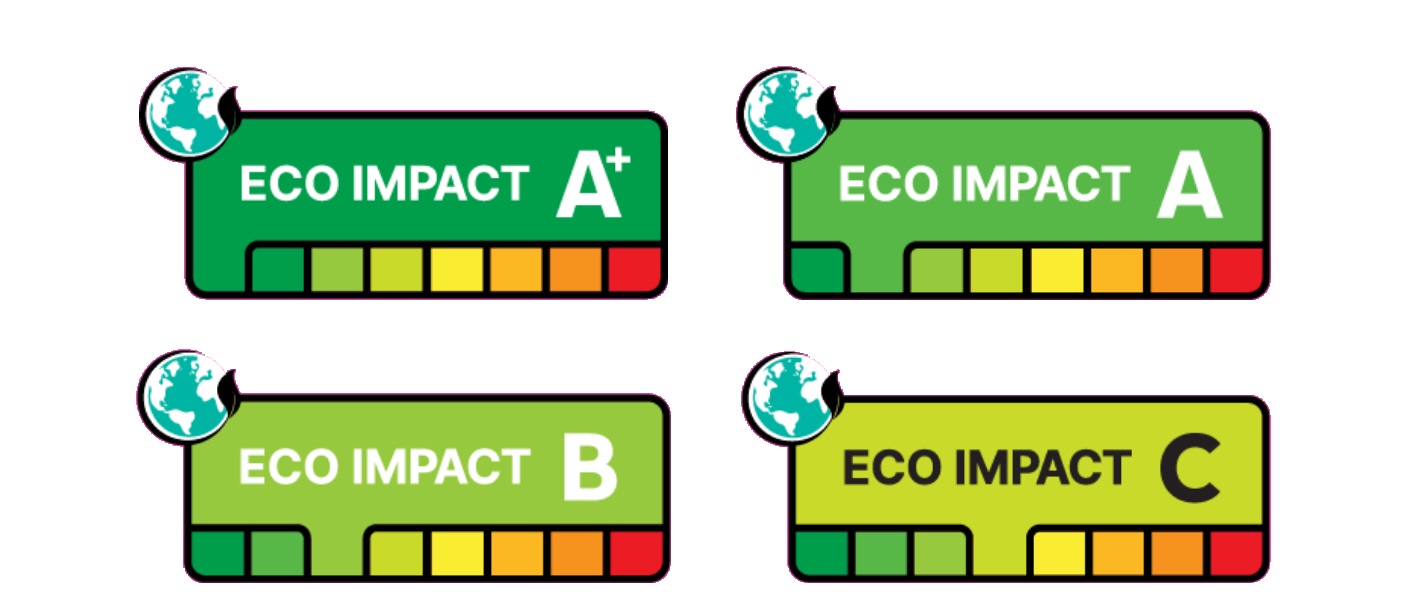
Sustainable food: how can ecolabels help transform entire value chains?
By Laura Nolan and Cliona Howie, Foundation Earth
With sustainability being placed higher and higher on consumers’ agendas, people are turning to high-emitting industries to ask how they are playing their part in reducing environmental impacts on the planet. The food industry alone accounts for one third of emissions globally – and with population rising, the challenge of feeding the planet while lowering our footprint is becoming more real than ever.
Fact box
Agriculture alone accounts for 70% of global freshwater consumption (Source: FAO).
Food systems are responsible for one third of human-caused greenhouse gas emissions (Source: Nature Food).
Our global food system is the primary driver of biodiversity loss, with agriculture alone threatening 86% of the species at risk of extinction (Source: Chatham House).
Agricultural expansion drives almost 90% of global deforestation (Source: FAO).
On top of this, feeding an estimated world population of 9.1 billion people in 2050 would require raising overall food production by 70% (Source: FAO).
An increasing number of brands are making efforts to green their products, be more sustainable and communicate that to their buyers in a credible way. Many green claims are being made left, right and centre – but how do you back up and qualify a food product’s eco-friendliness in an accurate, transparent way? What is being measured exactly, and what information and data can we access to verify such claims? How can we move towards a food system that doesn’t just reward client-facing brands, but also farmers and producers who contribute to making value chains more sustainable?

The role of ecolabels
One example is the use of ecolabels placed on products, that show consumers just how much that item costs the environment in an easy, accessible way (you’ve most likely seen those traffic light systems on your home appliances!). This trend isn’t new: 84% of consumers believe it’s important for each person to contribute to sustainability (Source: Kerry Group, “Sustainability in Motion”), and many companies are starting to respond to the demand for corporate transparency – from fashion, to beauty, electronics and of course, food.
But what do ecolabels show exactly? Well, there are over 500 environmental labels out there: a lot of them focus on carbon footprint (CO2 emissions), some will tell you if a product is organic or not, and others try to look at a broader range of measures like water use, water pollution and biodiversity. Some even include other ethical indicators such as working conditions or animal welfare. The scopes are large and diverse, there is no “one size fits all”, and there isn’t a consistent, harmonised approach.
Regulation is underway – the European Union has worked towards the development of a unified method to communicate environmental information of products across the European Union – the Product Environmental Footprint (PEF) Method – since 2013. PEF, for example, measures 16 different environmental impact categories. The French government has also been building a national environmental scoring system for food products, and similar initiatives are underway in The Netherlands and Denmark.
We need better data!
And yet, current approaches to assess the environmental impacts of individual food products remain limited. Often, proxy data is used to generate an estimate of a product’s impact, and the true impact of a specific product is never known. That means that if an actor in the value chain (for example a farmer) is making active efforts to green its processes, that most likely won’t show up in the final score due to the use of averages.

Impact scores based on secondary data are easier, quicker and cheaper to obtain, but without accurate information on a product-by-product basis, environmental impacts cannot be meaningfully managed and the climate crisis will intensify. And without an accurate per-product understanding of where the highest environmental impacts are in a supply chain, food producers are not incentivised to grow, manufacture, transport or sell their products more sustainably.
Here’s the thing: ecolabels don’t only help consumers choose a product – when the assessments are done accurately and in-depth, using methods such as Life Cycle Assessments (LCA) for example, they can also help food producers reduce the environmental impacts of their production and produce in a better way. They act as key source of intelligence to help industry players pinpoint where their highest impacts are, and what can be done to improve them. That’s when ecolabels also become a powerful data-driven tool to build more sustainable food systems.
At Foundation Earth, we are working to develop a method that scores food products in the most accurate way possible, based on LCAs using the highest quality data available. We map the supply chain, assess the impacts throughout and tell brands where they might be going wrong. At the same time we are comparing different existing methods to pull out the best of them all and create a single method that will allow brands to have a comprehensive view of their supply chain and know where improvements can be made.
Recognising actors across the supply chain
So, brands are starting to place more and more emphasis on their sustainability efforts – but what does this mean for the other actors along the supply chain? The nice shiny label is sitting on the product pack, but how does that help all food players, from farmers to marketers, to demonstrate their sustainability efforts?
For now, it doesn’t really. Everyone in the chain has contributed to that final score (either negatively or positively!), so why do they miss out on the acknowledgement? At Foundation Earth we believe there is a real gap here, because to transform entire food systems we need to recognise the do-gooders and incentivise others to join in these efforts. If a farmer is doing their best to place sustainability at the heart of their business model, and probably even seeing the direct benefits of their actions on biodiversity around them – for example – this should be celebrated. Because every effort counts.
That’s why we are launching new pilots calling all pioneers to be part of Foundation Earth’s trials and pave the way for food system transformation. We are aiming to deliver a standard, scalable product footprinting system not only for brand owners but also producers and retailers, that will connect entire value chains and give recognition where it is due by delivering our label across the chain. This will in turn unlock commercial value for businesses and support all actors in achieving their net-zero goals.

A food ecolabel for all
What will this look like concretely? We already have our scoring system for final products – remember that traffic light system mentioned on your home appliances? Our Foundation Earth Eco Impact labels apply a similar system: our scores range from A+ to G (A+ being green and representing the lowest environmental impact, G being red and representing the highest) and are re-certified yearly, making it possible for products to improve their grade. But instead of labels just being on final, packaged products, ingredients and processes could be certified at each step of the value chain as well, bringing recognition to all those businesses applying sustainability principles and helping business-to-business (B2B) buyers find alternative, sustainable options.
Transforming food systems for the better will take active participation from us all. And it’s only by recognising and celebrating efforts that we will build a movement big enough to create actual change and leave way for food systems that won’t harm the planet.
Highlights
Sustainability is being placed high on consumers’ agendas, and as a result being reflected more and more in brand’s business models.
Ecolabels are a powerful tool to give consumers the confidence to choose more sustainable products.
There are many existing ecolabelling schemes and methods, that look at various indicators. The European Union has worked towards a unified method, the Product Environmental Footprint (PEF).
Currently a lot of methods use proxy data – industry averages – which don’t reflect the true impact of an individual product.
Undertaking Life Cycle Assessments (LCA) on individual products enables accuracy and generates intelligence to help businesses produce in a better way.
We need to not only recognise the brands, but all producers from farm to retail. A certification scheme across the value chain could reward those sustainability efforts and incentivise others.


